
The Project Gutenberg EBook of The Insect Folk, by Margaret Warner Morley This eBook is for the use of anyone anywhere at no cost and with almost no restrictions whatsoever. You may copy it, give it away or re-use it under the terms of the Project Gutenberg License included with this eBook or online at www.gutenberg.org Title: The Insect Folk Author: Margaret Warner Morley Release Date: July 8, 2006 [EBook #18790] Language: English Character set encoding: ISO-8859-1 *** START OF THIS PROJECT GUTENBERG EBOOK THE INSECT FOLK *** Produced by Joseph R. Hauser, Janet Blenkinship and the Online Distributed Proofreading Team at http://www.pgdp.net
AUTHOR OF "SEED-BABIES," "FLOWERS AND THEIR FRIENDS" "LITTLE WANDERERS," ETC.
BOSTON, U.S.A.
GINN & COMPANY, PUBLISHERS
1903
Copyright, 1903, by
MARGARET WARNER MORLEY
All rights reserved
Dear Children,—The very best way to know the insects is to go and watch them. Watch them whenever you can, and each time you will find out something new. Books will help you, but you must watch, too. Look more than you read.
If you need to catch them, put them under a tumbler, and feed them and give them a drop of water every day to drink. Slip a card under the rim of the tumbler on one side so as to let in the air. If you do not know what to feed them, or if they will not eat, let them go after a day or two.
If you wish to kill an injurious insect, do it quickly and completely. Remember the insects are alive, and we should not make them suffer unnecessarily.
Of course you must try to make your captives feel at home. If they live in the sand, put sand in the tumbler and tie a piece of netting over the top so they cannot escape.
If they live in the water, put them in a tumbler of water. And when you have secured your captives, watch them as much as you can.
If you do not know how to pronounce the words in this book, study the glossary at the back and it will help you.
I hope you will have a very happy time getting acquainted with your little insect neighbors.
MARGARET WARNER MORLEY.
Boston,
April 18, 1903.
| PAGE | |
| Our Pretty Dragon Flies | 3 |
| The Fairy May Flies | 25 |
| The Stone Fly Folk | 33 |
| The Silver Fish | 36 |
| The Old Cockroaches | 41 |
| Neighbor Walking Stick | 52 |
| The Grasshopper Tribes | 59 |
| The Shorthorned Grasshoppers | 61 |
| The Longhorned Grasshoppers | 81 |
| Pretty Katydids | 94 |
| The Cricket-like Grasshoppers | 99 |
| The Cheery Cricket People | 101 |
| A Large Family | 107 |
| The Great Bug Family | 115 |
| The Water Boatman | 116 |
| The Funny Back-swimmers | 124 |
| The Giant Water Bug | 125 |
| Little Mrs. Shore Bug | 127 |
| The Airy Water Striders | 127 |
| A Queer Fellow | 129 |
| The Well Dressed Lace Bug | 132 |
| A Bad Bug | 133 |
| The Troublesome Red Bug | 135 |
| The Ravenous Chinch Bugs | 138 |
| The Well Protected Stink Bug | 139 |
| The Louse | 142 |
| Bird Lice and Book Lice | 142 |
| Friend Cicada | 143 |
| The Odd Spittle Insect | 152 |
| Pretty Leaf Hoppers | 154 |
| The Comical Tree Hoppers | 157 |
| The Jumping Plant Lice | 157 |
| The Aphids | 158 |
| Scale Bugs | 165 |
| The Horned Corydalus | 175 |
| Fairy Lacewing | 183 |
| The Ant Lion | 187 |
| The Little Caddice Flies | 190 |
| Glossary | 197 |

Come, children; come with me.
Come to a pond I know of.
See how the water shines in the sun.
Over there is an old log lying on the edge of the pond.
It is covered with green moss, and a green frog is sitting on one end of it.
Let us go and sit on the other end.
Goop! he says, and—plump! he has jumped into the water.
That is too bad, frog; we did not mean to disturb you.
How pretty it is here!
See the pickerel weed growing out in the water with its arrow-shaped leaves, and its spikes of purple flowers.
See, down in the water are little fish, and very likely pollywogs are there too, and lots of queer little things.[Pg 4]
But who is this darting over the pond?
Ah, we know you.
You are our queer little, dear little old dragon fly.
Look, children; see the dragon flies darting about like flashes of light in every direction.
They are having such a good time.
Whizz! One flashed right past Mollie's ear.

Pretty people, I wish one of you would come and sit by us a little while, so we could get a good look at you.
What is that, Ned? You have found a large one lying on the ground?
Sure enough; it is a beauty too, with a green body and silver wings.
Something seems to be wrong with it; it does not fly nor try to get away.[Pg 5]
What a big one it is!
My! my! what eyes!
Don't crowd, Amy; let little Nell see too.
What is that you say, Richard? "It catches mosquitoes and gnats and flies and other insects while flying."
Yes, and that is why it has such big eyes. We should need big eyes ourselves if we were to spend our time chasing mosquitoes.
Two eyes you have, little dragon fly, like the rest of us, but your eyes are not like ours.
No, indeed!
Each of your big eyes is made up of a great many small eyes packed close together.
Do you know, children, that some of the largest of the dragon flies have as many as twenty thousand facets, or small eyes, in each large eye?
Think of it! Forty thousand eyes in one little dragon fly head. It ought to see well.
These facets are six-sided, excepting those along the edge, which are
rounded on the outside. You cannot see their real shape without a
microscope, they are so small. But here is a picture of some facets as
they look under the microscope.
as
they look under the microscope.
Eyes like these, made up of many facets, we call compound eyes.[Pg 6]
All grown-up insects have compound eyes, though not many have as large ones as the dragon fly.
Only insects that chase other insects or that need to see in the dark have very large eyes.
See what a big mouth the dragon fly has. Its jaws do not show unless it opens its lower lip, which fits over its mouth like a mask.
I should not care to have it bite my finger.

It could not hurt very much, and its bite is not poisonous, still I shall handle it carefully.
Some call the dragon fly a darning needle, and say it sews up people's ears when they lie on the grass. This is not true. It does not sew up anything. It has nothing to sew with.
Why should it want to sew up people's ears, anyway?
It does nothing unpleasant but bite fingers, and it never goes out of its way to do that.
If we let it alone, it always lets us alone.
It is our good friend because it catches mosquitoes. For this reason it is sometimes called mosquito hawk.
We should never kill a dragon fly.[Pg 7]
Sometimes it is called a spindle, I suppose because it is long and slender like a spindle.
Down South the colored people believe the dragon fly brings dead snakes to life, and they call it snake doctor.
In some places it is called snake feeder.
But it has nothing to do with snakes, dead or alive.
The French have given it a pretty name, demoiselle, or damsel fly, and that is quite deserved, for the dragon fly is a graceful little creature, as pretty as pretty can be.
See, sticking out of the front of its head are two little feelers, or
antennæ, as we must call them.
or
antennæ, as we must call them.
They are very short, but it does not need long ones.
Insects smell with their feelers, you know, but our dragon flies see so well they do not need to smell very well, I suppose.
See how it can turn its head around. That is because it has a little short neck between its head and its body.
Its eyes, its mouth, and its antennæ belong to its head.
Of course our demoiselle can fly well; one need only look at those wings to know that.
To fly well is quite as necessary to one of its habits as to see well.
What would be the use of seeing an insect if it could not fly fast enough to catch it?[Pg 8]
We all like your pretty wings, little dragon fly; they look like glass and they shine so in the sun.
How fast the wings can move! See that dragon fly skimming over the pond; its wings make a whizzing sound as it darts about.

Why does it zigzag so?
Why doesn't it fly in a straight line?
Yes, Mollie, you are right, it goes zigzagging along after insects.
It sees one it wants off at one side—whizz! around it turns after it.[Pg 9]
Shouldn't you like to fly like that, children?
And yet we would not be willing to exchange our arms and hands for wings.
We could not whittle a stick nor write a letter if we had only wings.
In fact we could not do most of the things we now do.
I am glad I have my hands.
We are glad, too, that the dragon flies have their pretty, swift wings.
They have four wings, all nearly the same size and shape, you see, and they are all stiff and shining.
Some dragon flies, like this one we have picked up, always keep their wings spread out.

But over there, standing on the end of that stick, is another kind.
When it rests its wings are folded together.
What a pretty one it is! Do you see it?
It is small, but so pretty.
It is bright blue and shines as though it had been polished.
Sometimes birds catch these smaller dragon flies, though birds, as a rule, are not fond of any of them.
They are so hard and their wings are so stiff I should think a bird might almost as well swallow nails.[Pg 10]
I am sure no bird could swallow one of the big ones, wings and all!
But frogs can.
A frog will try to swallow almost anything it can catch, and it watches for the dragon flies when they come to lay their eggs in the water.

Suddenly it jumps out, and away goes poor dragon fly into that great wide frog-mouth.
Now look at the legs of the dragon fly. It has six.
Every dragon fly has six legs.
They are rather short and small for so large an insect, but that is because it does not need large, strong legs.
You never saw a dragon fly dig a hole, or run, or even walk, did you?
Their legs are not arranged for walking. All six of them are directed forwards as though they were reaching out after something. And so they are—reaching out after insects.
Dragon fly catches his prey while he is flying, and he grasps the insects with his feet.
He snatches one, and then what?[Pg 11]
Does he sit down somewhere and eat it?
Not he, he is far too hungry for that; he continues his swift flight, and as he flies he eats.
As soon as he has finished one fly or gnat, zip! he snatches another.
He has an insatiable appetite, consuming hundreds of insects in the course of a day. Nor does he confine his attention to flies and gnats and mosquitoes and such small fry. He catches what he can. A large dragon fly will even gorge himself on one of the large-sized butterflies, and one has been seen calmly chewing away at an enormous wasp!
No, indeed, Mabel, the dragon fly does not eat the wings of the butterfly, it eats only the soft body.
Probably nothing eats a butterfly, wings and all. Birds and insects sometimes catch butterflies, and you often see the bright wings lying on the ground. The wings of insects are not worth eating, and are almost always cast aside by the creatures that eat the insects.
Besides catching insects with their legs, the dragon flies cling fast to things with them, but when they wish to move they do not walk, they fly.
Yes, indeed, Frank, you are right; their legs are jointed.
That is so they can move them easily and fold them up when they want to.[Pg 12]
They would find it as hard to get along without joints to their legs as we should.
Wouldn't we be stiff if we had no joints!
See, the legs and wings are fastened to the middle part of the body, the thorax, we call it.
All insects have the legs and wings attached to the thorax.
The rest of the body is the abdomen. See how long it is.

It is the long abdomen that gives the dragon fly its name of spindle, I suppose.
The abdomen is jointed, and it can curl up.
All grown-up insects have a head, a thorax, and a jointed abdomen.
What are you looking at, Charlie?
Something moving in the bottom of the pond?
Let us get it out.
Here, we will dip it out with this cup.
What a lot of stuff!
Sticks and mud—and—what is that?
Something alive, surely.
Let us put some clean water in the cup and examine what we have found.
My! my! what a queer little thing!
What do you suppose it is?[Pg 13]
Ah, I know now, but I do not think you could ever, ever guess, not if you tried a week.
It is a young dragon fly!
It does not look much like its shiny-winged parents.
It looks like I don't know what, with a face like—well, when you look right in front of it, like a pug dog.
Queer! Well, I should think so! What is that, Amy? Am I sure it is a dragon fly?
Yes, there is no mistake; a dragon fly one day dropped an egg in the pond, and out of it hatched—this.

It will some day become a shiny-winged dragon fly and catch mosquitoes.
We will call it larva, and we will watch it a little while.
Look and see if it has a head, a thorax, and an abdomen.
Are there antennæ on its head? And has it eyes?
If you were to look at its eyes with a microscope, you would find that they are made of six-sided facets, like the eyes of the grown-up dragon fly.
They are compound eyes, but they are not as large as the eyes of the grown-up dragon fly.
How many legs has it? What are its legs fastened to?[Pg 14]
Yes, Nellie, thorax is right.
Its six legs are fastened to its thorax. I am glad you remembered thorax.
Has it a jointed abdomen? and has it wings?
Look! did you see that?
It opened its innocent-looking face all of a sudden, just darted it out into a long-handled spoon, with hooks at the end, and hooked up that little grub.

Now it is holding the grub on the hooks in front of its mouth and eating it as greedily as if it were half starved.
So that is why its face looks so queer.
It is its long under lip all folded up in front like a mask that makes it look like a pug dog.
When it pleases it darts out that lip, and any unlucky insect or snail may fall a prey to its greedy appetite.
It is said that the larvæ of some dragon flies even eat pollywogs and small fishes.
Ned wants to know if "larvæ" means the same as "larva."
Yes, it is the plural form of the word. When we speak of only one we say "larva"; when we speak of more than one, instead of saying "larvas," we say "larvæ."[Pg 15]
The dragon fly larvæ are terrible gluttons, and hidden under the mask are strong jaws for chewing up their prey.
Their legs are quite large and strong, too, for they crawl about the bottom of the pond or up the stalks of the plants.
They do not move about very fast, but they do shoot out that under lip very, very, very fast indeed, so good-by to any little live thing in the pond that comes within reach of it.
The dragon fly larvæ do not all look alike. They are different in the different species of dragon flies, and, like the rest of us, they change as they grow older.
Yes, May, you can keep the dragon fly larvæ until they change into dragon flies.
You must supply them with fresh water and with enough to eat.
And you must put a net over the bowl or aquarium in which you keep them, otherwise as soon as they are able they will fly away.
How can they fly without wings?
Oh, but they are going to have wings. You know they are young dragon flies in spite of their strange appearance.
Be sure and feed them enough, or else they will eat each other, and that would be a pity; and be[Pg 16] sure there are some water plants for them to hide under and crawl upon.
You can give them a little fresh fish or a tiny bit of very fresh meat, though they like best the living things they find in the bottom of the pond.

When the dragon fly larva first hatches it is very small and its legs are rather long and spidery, but it eats and eats and eats,—my, how it eats!
And it grows and grows, and one day it finds its skin too tight.
A tight skin must be rather uncomfortable.
But the larva does not care much for its skin.
It merely splits it open down the back and pulls itself out.[Pg 17]
Perhaps you think it must be yet more uncomfortable to be without a skin.
But it is not without a skin. It is covered by a new and soft one that soon hardens, and that is larger than the old one.
It wriggles out of its old skin as though it were an old coat, and leaves it clinging to the weeds in the pond.
Sometime you may find these cast-off dragon fly overcoats.
After it has shed its skin the dragon fly continues to grow. It keeps on growing until it has outgrown its new skin.
Then what do you think it does?
Yes, Charlie, that is right, it sheds this skin too.

When it sheds its skin we say it moults.
It moults several times, and at last little short wings appear. At first it has no wings at all, you know.
Amy wonders how the larva breathes under water.
Ah, Master Ned, you are laughing too soon. You think insects do not have to breathe, but you are very much mistaken, sir.
Insects do have to breathe.
They would die if they could get no air to breathe.
Some of the dragon fly larvæ have an odd arrangement for breathing under water. They have a sort of syringe in the end of the body, and there are breathing pores or gills in the syringe.
The water goes in and out of this syringe, and the larva breathes as the fish does, by means of its gills.
Yes, May, its gills are in its syringe, which seems very odd,—you see the dragon fly larva breathes at its tail end instead of at its head end.
Mollie thinks it is an upside-down, inside-out sort of a creature anyway. But it knows what it is about.
Ned wants to know how it can get any air to breathe when it lives under water.
The truth is, there is always air mixed in with water, and it is this air the larva breathes when the water goes in and out of the syringe.[Pg 19]
It uses the syringe for another purpose too. When it pleases it can shoot out the water with great force, and thus propel itself quite a distance.
By means of the syringe it can leap through the water faster than it can move by its slow-going legs.
Mollie wants to know if we can see the syringe.
No, it is inside the body.
But there is a kind of dragon fly that has a pair of gills outside, at the end of the abdomen, instead of the syringe inside.
The best I can do is to show you a picture of one. Some day we may find it in the pond.

Those two feather-like parts at the tail end are gills.
Yes, John, it can propel itself through the water by rowing, as it were, with these gills.
There are some species of dragon fly larvæ that swim by moving the tip of the abdomen from side to side, as a fish moves its body when it swims.
But now let us return to our funny larva that lives at the bottom of the pond. It stays down there, eating and growing and moulting, for nine or ten months or even longer; then something very wonderful happens.
It suddenly feels a great desire to get up to the top of the pond.[Pg 20]

It climbs up a weed or a stick until it is clear out of the water.
Then its skin splits down the back for the last time, and out there pulls itself, not a larva, but a weak-looking dragon fly, with soft and flabby little wings.
Now is its hour of danger, and now is the time for such birds as like the taste of young dragon flies to help themselves.[Pg 21]
Catbirds seem to have a special fondness for these helpless insects, and have been known to eat them before the flabby little wings had grown stiff.
If the birds do not find the newly emerged dragon fly, it remains motionless an hour or so, but it does not remain unchanged.
Its wings stretch out and harden.
Bright metallic colors begin to play over them and over its body; and all at once—off it darts, away and away, glittering in the sunshine, a swift, beautiful winged creature.
Towards the end of summer you will often see dragon flies darting about in every direction.
They seem to come in swarms and I think they usually come where there are ponds or marshes, for in such places there are many gnats and mosquitoes.
Mollie wants to know why it would not be a good plan for people who live where there are many mosquitoes to raise dragon flies?
That is a very sensible idea, Mollie, and it has been tried.
Yes, indeed; some men once collected dragon fly larvæ, and took care of them until they changed into dragon flies.
Then what do you think happened?
As soon as they got their wings, away went those[Pg 22] dragon flies,—away and away, without stopping to catch a single mosquito for the men who had taken the trouble to raise them.
The dragon flies will not stay at home.
They fly so fast and so far there is no use raising them.
They are among the swiftest and strongest of insects.
How do the larvæ get in the ponds? Frank is asking.
I will tell you what I know about it.

The winged dragon flies mate, and the female then drops her eggs in the water or lays them on twigs in the water, where they hatch out into larvæ.[Pg 23]
The dragon flies have to be very careful when they go close to the water to lay their eggs.
You all know why.
Yes, it is because the frogs are on the watch to catch them.

The mother dragon fly knows the larvæ have to live in the water, and so she takes pains to put the eggs there; sometimes she even crawls down under the water on stems of plants to lay her eggs. Isn't she a wise little mother?
There are a good many species of dragon flies.
Some are large and some are small.
Some are bright and some are dull.
There are black ones and bright blue ones, or green ones with blue eyes.
Some are marked with red and yellow.
They are a very gay family.
The dragon fly family is also a very old one.
Indeed, it is one of the oldest families on earth.
Long before there were bees or butterflies or dogs or horses or human beings, there were dragon flies.[Pg 24]
Don't you suppose that may be why the dragon fly is such a strange-looking insect?
It does not look like other insects; it is very old-fashioned, like the pine trees.
Pine trees, too, belong to a very old plant family that lived long ago, before there were oaks or maples, or other trees that shed their leaves.
Now we must go home.
Good-by, green frog, you may come back to your log now.
Good-by, pretty dragon fly people, we shall never forget you.
Good-by, pleasant pond and moss-grown log, we hope to see you often again.


Come, children, and see! Hundreds and hundreds of them are dancing about.
What are they? Yes, May, they do make us think of the dragon flies, but they are like fairy demoiselles.
They are the May flies, fairy ships sailing in the sea of air.
See how they are tossed about.
Many have fallen to the ground, which is covered with them.
They live but a day, or sometimes only a few hours, and so they are called day flies, and also ephemeræ, which means short-lived.
They have eyes, as you can see, little round eyes, but their mouth is so tiny they cannot eat.
Strange little beings to come into the world so helpless!
How different from the strong, fierce dragon flies![Pg 26]
See their dainty little legs. Six, you see, and legs and wings grow out from the thorax.
Have they an abdomen?
See the long threads at the end of it, they look like slender tails. How they spread these threads out as they fly!


They have four wings, but the wings are not shaped like those of the dragon fly, and they are very much more delicate.
Yes, May, I agree with you, they look like fine lace.
The fore wings, you see, are larger than the hind ones.
Richard asks, "Where do May flies come from? and why are they called May flies?"
Now, Richard, one question at a time, if you please, and the last shall come first because it is easier to answer.
They are called May flies because they often come out in the month of May, though sometimes not until June, and some species are as late as July in appearing.

We shall have to look into the ponds and little streams to discover where they come from.
See, John has scooped up some little speckled grubs out of the mud. Is it possible that they[Pg 27] are the larvæ of our fairy May flies? They have a mouth!—see what big jaws for such little creatures.
And what do you suppose they eat?
No doubt they, too, live on animal food.
No doubt they move about in the mud and catch what they can.
You see, John had to dig them up; they like to burrow in the weeds and mud, and some of them even make tunnels of mud in which to protect their soft bodies. Their short, stout legs enable them to dig well.
Their bodies are soft, but their jaws are not. O dear, no!

The grown-up May flies mate, and then the female drops her eggs on the surface of the water. When she does this a fish will very often jump up and seize her, for fish are very fond of May flies, and lucky are the May flies to escape these ravenous enemies.
The eggs are heavy and sink to the bottom, where they hatch into these queer-looking larvæ that eat and grow and shed their skin just like the dragon fly larvæ.
Those brushes along their sides are the gills they breathe with.
See the gills moving swiftly back and forth; they[Pg 28] look as though the larva wished to swim with them, but this is not why it moves them so constantly.
The continual motion of the gills stirs up the water and keeps our larva supplied with fresh air.
Nellie is asking what gills are.
Well, gills in fishes and in such insects as have gills, and in crabs and lobsters and other creatures that live in the water, are parts that often look like fringes or flat plates.
The gills of fishes have a great many blood vessels running through them. The walls of these blood vessels are very thin, and the oxygen from the air that is in the water passes into the blood that is in the gills, and then this blood, all full of oxygen, circulates through the fish's body.
You see in fishes the blood vessels come into the gills and get the oxygen.
In insects it is different. There are air tubes running like tiny pipes all through the gills and into the body of the insect. The oxygen of the air that is in the water passes out through the walls of these tubes into the blood of the insect.
Yes, John, in fishes the blood comes to the air, in insects the air goes to the blood. The air passes into the air tubes of the insects, and thus is carried all through their bodies.[Pg 29]
The blood takes the oxygen out of the air.
Without oxygen in the blood no animal could live.
Now let us go back to our May flies. They remain in the larval state a year, and some species remain two years. Think of living in the mud for two long years!
In the mud they creep about, eating, eating, eating. Then some summer day they leave the mud and swim to the surface of the water.
Pop! they are gone.
They were so quick about it we could not see what happened.
The larval skin burst open and forth leaped the May fly, like a winged fairy from a prison cell.
They do not come out slowly and wait for their wings to dry like the dragon fly.

They spring out all of a sudden and fly away, leaving their cast-off skin in the pond.[Pg 30]
Unless their motions were quick they might be snapped up by the fish that are so fond of them.
But though they seem to emerge thus quickly into perfect winged May flies, they are not quite done with infancy. They are still wrapped about by a very delicate skin that they have to get rid of. So they fly to a bush near the water and stay a little while until this skin splits and comes off, and they are free.
In spite of their quick motions when they spring from the water, many of the May flies fall back into it and are caught by the fish.

It is said that the trout become fat and good-flavored when the May flies emerge, they eat so many of them. And what the fish do not catch the birds try to. Swallows and other insect-loving birds have a glorious feast when the May flies come out. For a season they live in the midst of more delicacies than they can possibly use.
Fish like the May fly larvæ, too, which is probably the reason the larvæ have learned to live in the mud, out of reach.
Fishermen dig up the larvæ for bait, so you see the May flies have a hard time to get safely through the world.
But in spite of difficulties a great many of them live, and some summer day out they come trooping.[Pg 31]

They spring all at once from the surface of the water as by magic, hundreds and thousands, yes, millions of them. They fill the air, they cover everything.
The great naturalist Swammerdam, who was the first to make a thorough study of the May flies, thus tells us how they appeared in France one year:—
"I then saw a sight beyond all expectation. The ephemeræ filled the air like the snowflakes in a dense snowstorm.
"The steps were covered to a depth of two, three, or even four inches. A tract of water five or six feet across was completely hidden, and as the floating insects slowly drifted away, others took their places. Several times I was obliged to retreat to the top of the stairs from the annoyance caused by the ephemeræ, which dashed in my face, and got into my eyes, mouth, and nose."
These swarms of May flies appear only from three to five days at a time.[Pg 32]
Wherever there are streams there are May flies, and the canals of Holland make good breeding places for them; no wonder, then, the Dutch, who you know live in Holland, have a saying, "As thick as May flies."
Although so many of the May flies perish at once, multitudes of them drop their eggs into the water to renew the race of May flies.

Is it not wonderful that after so long a period of creeping about in the mud as larvæ, these graceful and beautiful little creatures have but a few hours in which to dance joyously about in the upper air on wings of gossamer? Some, indeed, live less than an hour, and some, that come out in the evening, finish their dance of life and perish before sunrise, without ever having seen the beautiful daylight.
Yes, strange little beings are they.
They do us no harm and we should not kill them.
Let them live their short lives and be happy.[Pg 33]

John has been fishing.
What do you think he caught?
Nary fish, my dears, but a goodly number of stone flies, which he has brought to show us.
Yes, Mollie, they do remind us a very little of our May flies, only, of course, they are many times larger.
It is rather a clumsy creature in spite of its large wings, and John says he had no trouble whatever in catching it.
See, it has four wings, and the hind ones are the larger.
Yes, May, they fold up in plaits, like the sticks of a fan.
See its long antennæ and its compound eyes. Its eyes are not so large as are those of the dragon fly. It does not spend its time pursuing other insects, but is more like the May fly after it gets its wings.
Yes, Ned, it lives longer than the May fly, but it does not live very long, and it eats little.[Pg 34]
It is a pretty little gray thing as it rests on the side of John's box, with its wings folded like a gossamer cloak over its body.

It lays its eggs in the water, and out of them hatch little six-legged larvæ that are not troubled by want of appetite. If the winged stone fly does not eat, its larva does; it is like the other larvæ we know, always devouring something.

Yes, Charlie, it feeds on living creatures, greatly relishing the larvæ of the May flies, or any other luckless insect infants it can capture.
It grows fast and moults several times, and when winter comes it hides away, only to come forth at the first breath of spring and continue its eating.
Like other larvæ that live under water, it does its breathing by means of gills, and these gills are in little tufts just above the base of each leg.
It lives under stones, which is why it is called the stone fly, and it slides quickly around a corner when you lift up its stone.
Fish are very fond of it, and hunt it as eagerly as it hunts larvæ. Since it makes good bait for brook trout, its life is always in danger. It finishes[Pg 35] its growth in early summer, and emerges from its larval skin as a perfect winged insect.
Yes, indeed, John, you can often find dozens of the cast-off skins of the stone flies along the brook sides in the month of June.
The stone flies are harmless little people, and we should never kill one needlessly.


May has something here for us to look at. She says it is a slippery rascal. Let us see it. Oh, yes, you have it in that little box. See, the box has a glass top. May cut the top off the box herself, and fastened in a little pane of glass so we could see the rascal without danger of its escaping.
Pretty rascal! Like a little silver fish slipping about the box.
Yes, Charlie, it is called the silver fish. A land fish? Why, yes, it would be a land fish if it were a fish at all. But in spite of its name it is no fish. It is covered with shining scales, though, that are very much like fish scales, and it is shaped a good deal like a fish.
Oh, yes, it is an insect. You see it has six legs. But it has no wings.
No, it is not a young one.
It never will have any wings, no matter how old it may get to be.[Pg 37]
It is flat, you see, and its scales make it very slippery, so that it is hard to catch and yet harder to hold on to after you have caught it. It goes flashing about like a little silver dart, and it loves to eat starch.
That is why May calls it a rascal. It eats the starch from the paste that fastens on her wall paper, and from book-bindings, so you see it makes things fall to pieces. But my! what a pretty rascal it is! Besides its name of silver fish, it is also called fish moth, though it is not a moth at all. It is also called bristle-tail, because of the long, bristle-like parts at the end of its body; and in some places it is called a slink, because, you know, it loves dark places, and when you uncover it in the daytime, it slips around a corner into the dark again.
Yes, it seems to slink about as if it were ashamed of itself, but it is not ashamed; it does not like the light, and it does not like us to see it.
Perhaps it is afraid of us.[Pg 39][Pg 38]

Children, here is a cockroach.
It was one of the first insects that came to live on the earth; cockroaches were here before people, and they are here yet.
You do not think it is pretty?
Neither do I.
I don't know anybody who thinks a cockroach pretty.
Oh, no, it won't bite you.
It will only get into your pantry and eat your food.
It will walk around in the night and frighten you if you go suddenly into the kitchen.
It will not frighten you on purpose, but when it hears you coming, it will run, and then maybe you will scream and run too.
What is that, May? You've a good mind to scream and run as it is?
Very well, scream and run if you want to; the cockroach won't care.
We do not often see these big black fellows in the North, but sometimes we do. Down South cockroaches seem to be everywhere.[Pg 42]
What, May? You are never going South, then?
Well, you do not need to go; the cockroaches won't care.
They have little heads and long antennæ, like threads.
What is that, May? You don't care anything about their heads? You don't want to know anything about cockroaches?
Oh, yes, you want to know about cockroaches. Remember how old they are.
They have six legs, you see.
You don't care how many legs they have?
Oh, yes, you do. They could not walk if they had no legs.
You wish they couldn't walk?
Dear me, May; you don't seem to like cockroaches.
Poor old cockroaches.
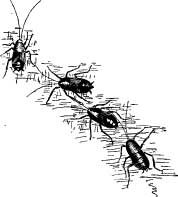
Think how old they are.
What is that you say? They are old enough to know better?
Why, May, what have they ever done to you?
Nothing, only you don't like them?[Pg 43]
Well, well, they don't like you, either. Poor old cockroaches; nobody seems to like them.
Perhaps they don't care.
Will you let me tell you where they came from?
They do not belong to this country.
Their natural home is tropical Asia.
You see, about four hundred years ago, the ships that bore fruits and other merchandise from India and other warm countries in Asia, bore, as well, a number of little, flat, reddish brown stowaways.

Stowaways, as you know, are people that do not buy their tickets, but that hide among the ship's cargo, and so get free transportation to other countries.
Well, these little flat stowaways were not human beings, they were insects. Yes, May, they were the cockroaches.
When they landed from their hot land of Asia in cold England, they must have wondered what was to become of them. Many of them no doubt died, for they cannot stand cold weather at all; but some of them were carried, with the fruits and other things, quite unintentionally, of course, for nobody guessed they were there, into warm cellars and kitchen cupboards.[Pg 44]
Then they felt at home!
They knew better than to leave the cosey nooks where they could hide away and sleep all day, and when they came out at night would find a delicious supper close at hand.
They are great eaters, you know, so what with the good things in the pantry and the warmth of the kitchen quarters they prospered wherever they could find a kitchen to live in.
Soon they spread all over the large cities of England and finally into even remote country districts.
Of course they found their way to the United States of America, and in many houses in the North they have taken lodging. But down South, where it is always warm enough, they have prospered greatly, and they are there in far greater numbers than in the North.
Besides, there is a large American cockroach that belongs to tropical America, but that has found its way pretty well over the country. And there are cockroaches that live in the woods, some of them coming in the night to visit our houses and help themselves from our pantries.
Yes, Mollie, the cockroaches eat almost anything they can find, and what they do not eat they spoil by an ill-smelling liquid they give out when disturbed.
It is this liquid that makes the cockroaches so very[Pg 45] offensive to us. We cannot bear to touch one because of it.
Cockroaches eat one variety of food that nobody objects to their having. They are fond of bed bugs and greedily devour them.
Besides the large, dark, reddish brown cockroaches there is a little tan-colored fellow that is often very troublesome.
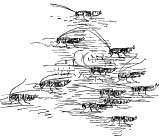
It is not a native of this country, but is supposed to have been brought to England by soldiers from the Crimea, and later it found its way to America.
We call it the croton bug, but it is not a bug at all, it is a cockroach.
It is particularly numerous about water pipes, and, like the rest of the cockroaches, it hides in the daytime.
At night out troop crowds and crowds of the little tan-colored water bugs. They run about the floor, and over the pantry shelves. They get into everything they can find, and have a beautiful time.
They are funny little fellows, and if they were not so troublesome, we might admire them.
How they can run!
All the cockroaches run very fast, so that it is hard to[Pg 46] catch one. And they are hard and smooth, too, which makes it yet more difficult to catch them. They are well made to escape their enemies, and they are so flat they can hide in cracks or almost anywhere.
No, May, they do not fly very much. You see this one has short wings. It is a male cockroach. The female of this species of cockroach has no wings at all, only little hints of wings, as it were.
Such little useless wings we call "rudimentary" wings.
John says he thinks that is a long word for short wings.
Yes, but it is not a hard word,—ru-di-ment-ary, see if you can remember it.
The croton bugs have longer wings and they sometimes fly.
If you were to spread out the wings of a cockroach, you would find it had four.
What is that, May? You wouldn't spread them out for anything?
Yet wise men have been very much interested in our poor, ill-smelling old cockroaches, and have studied carefully all about them.

If you dislike to touch the cockroach so much, perhaps you will look at this picture of a croton bug.[Pg 47]
See, the upper wings are different; the cockroach does not fly with them, he merely uses them to cover up the under wings, and we call them wing covers.
It is the under wings the cockroach flies with.
Cockroaches may not be pleasant, but who can say they are not interesting?
What other insect lays its eggs in little bandboxes?
Here is one of the little boxes, shiny and hard.

This little case is at first a sticky substance that soon hardens. The eggs lie in it side by side in two rows.
These cases remain attached to the abdomen of the female cockroach until the eggs are all laid. Then the case falls off, and soon out runs a crowd of infant cockroaches.
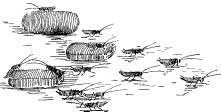
The case is something like a satchel that shuts with a spring. The youngsters are packed close together, side by side, with their heads towards the mouth of the satchel.
As soon as one hatches it pushes open the side of the case and creeps out. Then the case springs together again to protect the rest of the brood.[Pg 48]
They are funny fellows when they first come out, little and white-looking. But they eat and grow of course, and shed their skins, and after each moult they become darker in color.
Now, do look again at this cockroach I have taken such pains to catch for you and put into the tumbler.
I think even May will own that it has a cunning little head.
See it turn its head around to look at us.
After all, the cockroach is a knowing little fellow.
This one is hungry; it has had nothing to eat for some time. We will give it this crumb of cake.
Be careful, or it will get away; it can run very fast, and it is very quick, you see, in all its motions.
Ah, it is examining the crumb with the tips of its long antennæ.
See how daintily it touches the crumb.
It can smell with its antennæ, you know.
Now it has decided the cake is good to eat.
See how eager it is!

It almost stands on its head to reach just the part it wants.
John says he does not understand how insects smell with their antennæ.
I can tell you a little about it, John.
If you look at one of the cockroach's antennæ under[Pg 49] the magnifying glass, you will see it is made up of a good many short pieces, or segments, as we call them, fastened together end to end.
Yes, Mollie, that is why it can move about so easily. It can curl up like a whiplash, you see.
Next the head is a round segment that fits into a socket.

Double up your right fist and fit it into the half-closed palm of your left hand.
There! That is like the ball-and-socket joint.
You see you can move your fist around in all directions.
The insect can move its antennæ in all directions because they are fastened to its head by ball-and-socket joints.
On the segments of the antennæ, particularly towards the tip, are little dots.
You cannot see the dots without the help of a strong microscope, but they are there.
These little dots are sensitive spots. There is a nerve coming from the insect's brain to each dot.
Some of the dots are sensitive to odors, just as the nerves of our nose are sensitive to odors.
May thinks it is very funny that the insects smell with antennæ instead of with noses.
The insects, no doubt, would think it very funny for[Pg 50] us to smell with, noses instead of with antennæ, if they thought about it at all.
The little dots on the antennæ are extremely sensitive to smells. They are often much more sensitive than our noses.
Put a bit of food at some distance from a hungry cockroach, and it will not be long before a pair of long, sensitive feelers will come waving to and fro out of some dark corner.

Little Mrs. Cockroach has smelled the dainty morsel, and, as soon as it is dark, out she will run, her feelers moving eagerly this way and that, until she has found it.
Yes, May, insects also feel with their antennæ. That is why the antennæ are often called "feelers."
There are other dots on the segments that are sensitive to touch. Sometimes there are tiny hairs on the antennæ, also sensitive to touch.
The little fellows feel and smell, yes, and oftentimes hear with their antennæ.
Many insects have spots sensitive to sound on the antennæ.
Yes, indeed, May, it is wonderful that such tiny threads as an insect's antennæ should hold so many kinds of sensitive spots.[Pg 51]
An insect's antennæ are among the most wonderful things in the world.
And I think a cockroach, in spite of its bad reputation, is a very wonderful little fellow.
What is that, May? Our cockroach is drawing one of its antennæ through its mouth?
Ah, yes, see it clean its antenna, children.
It seems to nibble at it as it draws it through its mouth.
Insects are very careful to keep their antennæ clean.
It would not do to let these sensitive spots become covered with dust, you know.
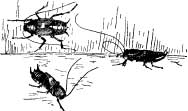

Isn't this a pretty place to sit down and—
"Ouch! ow! ow! ow!"
Why, May, what is the matter?
Anybody would think you had seen a cockroach.
What has she found, John?
Oh, it is a walking stick!
Why do I call it that?
Look and see.
Does it not look like a stick?
And does it not walk?
Then why is not walking stick a good name for it?
May thinks its legs look like a collection of pine needles, for they are green and flat on the upper joints.
It is as pretty as it is queer, with its brown body and its green legs.
This is the male walking stick; the female has brown legs. She is brown all over, just the color of dried leaves, and she is not as slender as her mate.
Mollie thinks it is the long and slender thorax that makes the walking stick look so queer.[Pg 53]
See its thorax. Its six legs are attached to its thorax, which is as long and as slender as the abdomen.
John thinks it looks queer because everything about it is so long and slender.
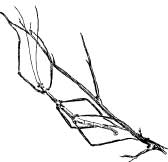
Long antennæ, long legs, long thorax, long abdomen—that is Mr. Walking Stick.
Sir, why do you have such long antennæ? Can you hear and feel and smell extra well because of them?
I wish you could tell us about them.
Now where is it?
Oh, yes, it is standing on that brown twig. It is so nearly the color of the twig and so much the shape of a little stick itself, that it is not easy to find it.
There, it is walking off again.
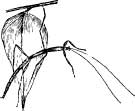
It has a good name, for I am sure that if a stick tried to walk, it could not do it more awkwardly.
See now, what it is doing, hanging by one foot from that twig.
How still it is.
Who would imagine, seeing it thus for the first time, that it was a living creature?[Pg 54]
The walking sticks feed on leaves, and I suppose their queer shape and their color protect them from being eaten by birds.
A bird would have to be very close to a walking stick to tell it from a twig.
The female drops the eggs on the ground, and leaves them to hatch out and make their way in the world as best they can.

The young walking sticks look just like their parents, only of course they are very small, and they are green in color, like the leaves they eat.
Yes, little Nell, I should like to find some too; they must be cunning little things.
They eat and grow and moult, and eat and grow and moult, until they are grown up.
There are a good many species of walking sticks in the world, particularly in hot countries; and to their family belong the longest of known insects, some being nearly a foot long. Just imagine a walking stick a foot long!
And some of them are quite prettily colored, though certain species are not pleasant to handle, as they give forth a bad-smelling milky fluid when disturbed.
They are gentle little folk, all of them, and move slowly about over the leaves and twigs, not wishing to harm any living thing.[Pg 55]
Some members of the walking stick family have wings, and these are even more curious than those that have none.
Their wings and legs are flattened to look like leaves, so that it is very difficult to find them among the foliage.

Yes, May, they are also the color of the leaves they live among.
Here is a picture of one that will give some idea of these strange little people.
We have none of these leaf-like insects in our country, but we do have a near relative to the walking sticks, though it does not feed on leaves, I assure you.
How many of you are acquainted with his lordship, the praying mantis?
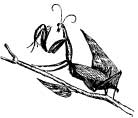
Charlie says he has seen these fellows in Kansas, and Nellie says she has a cousin in the South who has told her about them.
Here is a picture of one; is it not a beauty!
Its wings are green and its body is brown, so that it can stealthily creep about among the foliage without being noticed.[Pg 56]
When at rest it holds its front legs up as though it were raising its arms in an attitude of devotion.
But not a thought of devotion lies in that cruel little head. There is only one idea there; and if any unwary insect were to come along, those devotional arms would be thrust out with incredible rapidity, and the unfortunate insect clasped tightly in them.
Then the mantis, hugging its prey in the strong trap-like clasp of its spiked legs, would coolly proceed to devour it alive, eating it as a boy would eat an apple.

This praying mantis is called a "mule-killer" in the South, where the people think the brown liquor it spits out of its mouth, when disturbed, is fatal to mules.
The mantis is also called a devil-horse, a rear-horse, a camel-cricket, and many other names inspired by its outlandish appearance.
Some have even thought it looked wise, standing in that knowing attitude with extended arms, and so it has been called prophet and soothsayer, as though it could foretell what is going to happen.
Undoubtedly it never foretells anything but the approaching death of some insect and possibly a coming change in the weather, for insects often know[Pg 57] when the weather is going to change long before we do.
Although our mantes are brown or green, there are a great many species living in hot countries that are much more brightly attired; and when you find yourself on a visit to the tropics, you must look for the flower mantis.
It mimics in color the brilliant hues of the showy orchids in which it hides.
It does not seem to wear its gorgeous robes from a love for the beautiful, however, but rather that it may the better lie concealed in the heart of the gay flowers, to pounce upon unsuspecting insects that come there for refreshing draughts of honey.

In some parts of Africa the mantis is worshipped by the natives, and in France these fellows are believed to point out the way to travellers by stretching out one leg when questioned.
Its strange attitude, with uplifted arms, has won the mantis regard in all parts of the world, though the insects it clasps in these uplifted arms would not be likely to share the good opinion held of this hardy cannibal.
For it is a cannibal, and enjoys eating another mantis as much as anything else.[Pg 58]
The mantes are terrible fighters, too, and if there is a meeting between two of them, there is very apt to be a battle in which one is vanquished and devoured by the other.
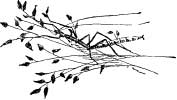
Our mantis lays its eggs, thirty or forty in number, on tree twigs, and they are embedded in a soft substance that soon becomes very tough and horny. These strange egg-cases of the mantis are easily recognized because they look as though they were braided on top, as you can see in the picture.
Yes, May, the tough covering is to protect the eggs from wet and from prying birds and hungry insects.

The young mantes are similar to their parents, only they have no wings. But they hold up their spiny front legs and catch insects, and they grow and moult in the usual way.
While we have been talking about leaf-like insects and mule-killers our walking stick has gone off.
Well, well, let him go, and good luck go with him.
I am glad you like the walking stick, children.
And now, May, let me tell you something.
This queer fellow is a very near relative of your friend, the cockroach.[Pg 59]
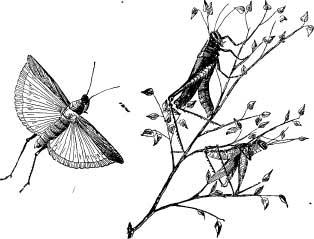
Don't you often wonder where they come from? The swarms of grasshoppers in the late summer?
Charlie says he walked across a field last night where he believes there were as many grasshoppers as there were blades of grass.
Just think of it! and yet they do not seem to do any harm.
In some places, however, they do a great deal of harm.[Pg 60]
They come flying in swarms that darken the sun, and they settle on the trees and the crops and eat up every green thing. There is nothing a Western farmer dreads so much as the passing of the grasshoppers.
Grasshoppers are funny little fellows, and we like them—when there are not too many of them.
Summer would not seem quite like summer unless we heard the grasshoppers shrilling.
There are a great many species of them, and we have placed them in two divisions,—The Shorthorned Grasshoppers and The Longhorned Grasshoppers.
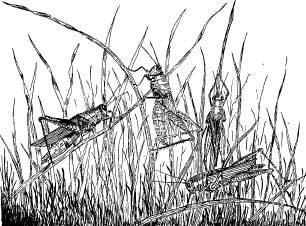
They have no horns, of course, but some have short antennæ that stick out like little horns, and those we call shorthorned.
The right name for the shorthorned grasshoppers is locusts.
We call another insect a locust, but the shorthorned grasshoppers are the true locusts.
Some say it was these locusts that John the Baptist ate with his honey in the wilderness.

A good many people in different parts of the world still eat locusts.
They are said to be good food when roasted, but I would rather eat roasted peanuts.
Come here, little locust, and let us look at you.
Now, stand still, and show us your short "horns."
See its eyes!
Yes, May, they are compound eyes, but I do not know how many facets they have.
What a funny little rabbit face it has.
See it move its little mouth parts.
It bites bits out of the leaves and chews them up very fast.
Has it teeth? May is asking.[Pg 62]
Well, yes, but not like our teeth. Sometime you must see the mouth parts of the grasshopper under the microscope. They are very interesting.
Mollie says the locust has a cape on.
John says the cape is the top of its thorax.
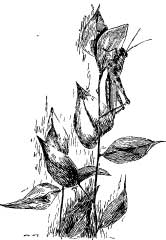
Frank has been counting its legs; he says it has six.
See it walk. It uses all six legs to walk with.
But it does something besides walk with its hind legs.
Yes, it jumps with them. How long and large they are! Now watch it jump.
See! It draws those long hind legs close up to its body, then suddenly straightens them out—and away it goes as though it had been shot from a spring board.
John says its hind legs work just like a spring, and so they do. It can leap several times the length of its body. Amy thinks it should be called a grass-jumper instead of a grasshopper.
Suppose we all look carefully at the locust's long hind leg, segment by segment.[Pg 63]
What, John? You do not know what a segment is?
Well, a segment is the part between two joints. The joints are where the leg bends, you know.
May proposes that we draw a picture of the long hind leg.
It will be fun to try.
There are two tiny segments close to the body.
If you are not careful, you will find only one.
You must look sharp to see both of them.
How well Charlie has drawn his! He has both the little segments.

The one next the body we will mark I, and we will call it the coxa.
The next little one we will mark II, and that we will call the trochanter.
The long, strong one, III, we will call the femur.
The next one, long and narrow, we will mark IV, and call the tibia.
All the rest of the leg, made of several short segments, we will call the tarsus, and we will mark it V.
Now how are we to remember all those hard names?
Here is a jingle that perhaps will help us:—
Coxa first, and then trochanter,
Number three the femur stands,
After this, the long, straight tibia,
And last of all the tarsus comes.
[Pg 64]
Now let us see who can learn it first.
Charlie says we are taking a good deal of trouble over the hind legs of a grasshopper.

Very true, Mr. Philosopher, but let me tell you something.
When we have learned the names of the segments in the grasshopper's hind leg, we have learned the names of the segments in the legs of all insects.
You see all the legs are made on one common plan, and it is very convenient, as you will soon see, to have the parts named.
What a fine set of drawings of the grasshopper's hind leg we have!
Why do you suppose the coxa and trochanter are so small?
Yes, John, it is in order that the leg can move easily.
The grasshopper can turn its leg in almost any direction because of these small upper segments.
It can put its leg up over its head if it wants to. Next to the little coxa and trochanter is the longest and largest segment in the grasshopper's leg; I suppose nobody remembers its name.
Listen to little Nell,—"number three the femur stands."[Pg 65]
So it does, and what a very useful femur it is!
If it were not for the long femur and the long, slender tibia, the grasshopper would not be a grasshopper—it could not hop at all.
Watch the grasshopper, and see how he uses those long segments to jump with.

First he draws the tibia close up to the femur—now he is off!
He just straightened those long hind legs out with a jerk, and away he went!
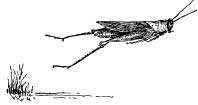
What do you suppose the two little sharp spines at the end of the tibia are for?
What, May? You did not see any spines?

Look again.
See, Charlie has drawn them very plainly in his picture of the grasshopper's leg. Mark them s, Charlie.
Now we must all look at Charlie's picture.
He says he thinks he knows what the spines are for[Pg 66]—they are to keep the grasshopper from slipping when he makes his leap forward.
I have no doubt Charlie is right.
May wants us to look at the beautiful little hinge x where the femur and the tibia are fastened together.

Let us mark it X.
See the little ball on the end of the tibia. How well it fits into the hollow on the end of the femur.
In order to see this hollow or groove, you must look on the under side of the leg.
Yes, John, it reminds us of the ball-and-socket joint, only this is a hinge joint, and does not move in so many directions.
The tibia can move towards the femur and away from it on this hinge.
When our little friend gets ready to jump, he draws the tibia close up to the femur. When he jumps, he pushes the femur quickly away from the tibia.
If you watch the grasshoppers, you will soon understand just how they use their hind legs in jumping.
The tarsus bends easily.
It has three joints.
The last segment is a cunning little foot.
What is John doing?[Pg 67]
He is looking at the grasshopper's foot through the magnifying glass. Wise John!
Let us all look.
Yes, Charlie, we will try to draw it.
Mollie has hers drawn already. Do not hurry too much, Mollie. You cannot draw well if you hurry.
See the sharp claw on each side of the foot.

Let us mark these claws a and b.
Between them is a flat little pad which we may as well mark c.
May says her picture looks like a crazy pond lily.
Let us see, May. Well, it is rather funny.
If I were you, I should try again. Any child can learn to draw who will keep trying.
Touch the grasshopper's foot with the tip of your finger.
How the little foot clings to you!
It clings by the two little claws that have caught in your skin, and that hold fast.

What do you suppose the little pad between the claws is for?
It is important, I can tell you.
John says he has heard there is a little pad in the fly's foot that enables it to walk on glass.
Yes, and it is the same with the grasshopper.[Pg 68]
The little pad between the claws is fringed with hairs.
You can see them with a good magnifying glass.
Out of the tip of each hair comes a little drop of sticky liquid.
This fastens the foot to any smooth surface.
Many insects have these sticky hairs on their foot pads.
When a fly walks up a window pane, it does it by gluing its feet, one after the other, to the glass.
I don't wonder you laugh.
No, Mollie, the glue does not harden and hold it fast.
The fly can easily pull its foot loose. The grasshopper cannot walk on glass quite as well as the fly. Its foot pads do not cling so well.

Would you not like to know the name of these curious little foot pads?
We call the foot pad a pulvillus.
Some insects do not have sticky hairs on the pulvillus.
There are beetles that simply put the pulvillus so flat against a smooth surface that it stays there by the pressure of the air above.
Some people think that is the way the pulvillus on the fly's foot acts.[Pg 69]
Perhaps it acts both ways, sucking fast and sticking by hairs.
John wants to know if the beetle's pulvillus does not act just like the "sucker" that boys make.
The sucker, you know, is a round piece of leather with a string attached to the middle.
When the leather is wet and laid flat on the floor or on a smooth stone, all the air below it is pushed out, and the air above presses so hard that a boy cannot pull the leather up from the floor.

You can peel it up from one edge and let the air under easily enough, and then a baby could lift it.
When the insect wants to move, it peels its foot loose.
It can do this very quickly.
Mollie wants to know what all these little sharp spines on the back of the tibia are for.
Let us look at them.
There is a double row of them.
Do they not look a little like a comb?
I suspect that is what they are, the grasshopper's comb.
Insects are very neat little folks.
They are always cleaning their wings and their legs and their antennæ and their bodies.[Pg 70]
The spines on their legs are very convenient for that.
Charlie says he thinks the grasshopper's legs are as good as a whole box of tools.
So they are, and you have not yet heard all they can do.
The funniest is to come.
Mr. Grasshopper sings his song with his hind legs!
He rubs the inside of his femurs against the outside of his wings.
There is a row of very fine spines down the inside of the femur for the use of the little fiddler.
He scrapes away with these on his wing covers.
Yes, Ned, his femur is his violin bow, and his wing cover is his violin.
The noise he makes does not sound much like a violin, little Nell thinks.
No, indeed, it does not.
It is the shrilling sound we hear in the grass in the summer time.
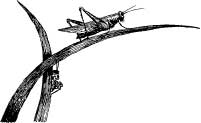
It is only the male grasshopper that sings.
The little lady grasshopper sits still and listens to him.
Now, let us look at the other legs.
The front pair are the smallest.
Can you find the little coxa and trochanter?[Pg 71]
Yes, Charlie, we will draw the little front leg.
Let us number the segments as we did those of the hind leg.
See, the femur is larger than the other segments, but it is small as compared to the femur of the hind leg.
The tibia is shorter, too, than the tibia of the hind leg.
The little tarsus is like the tarsus of the hind leg with its claws and its pulvillus, only, of course, it is smaller.
The middle pair of legs is like the front pair, only larger.
Now, see how the legs are placed on the grasshopper's body.

The front pair are directed forward. When the insect walks, they pull.
The middle and hind legs are directed backward. When the insect walks, they push.
Well, little legs, you all have your own work to do, and you surely do it very well.
Let me see, who has front legs as odd as the grasshopper's hind legs.

Yes, Mollie, the mantis has.
Let us look again at the mantis.[Pg 72]
Here is another picture of it.
Its hind legs are just common walking legs, you see.
And so are its middle legs.

John says they are directed forward instead of backward.
You can see why.
They have to take the place of the front legs, that do not touch the ground at all.
They have to hold Mr. Mantis up, and pull him along when he wants to walk.
Now, let us see if we can make anything out of these front legs.
The coxa is small and close to the body.
The trochanter, II, is very large and long.
Yes, Charlie, it increases the size and strength of the leg very greatly, by being thus enlarged.
The femur, III, is large and strong, too, and it has a row of sharp, spiny teeth down the inside.
The tibia, IV, is also well supplied with cruel teeth, and at the end of it is the tarsus, as you see.
You know how the mantis uses these legs. The joint between the tibia and femur is a strong hinge joint. If can shut the tibia close to the femur, the spiny teeth of the one locking into the spiny teeth of the other, and forming a terrible trap for the insects that are so unfortunate as to get caught in its merciless grip.[Pg 73]
Altogether, you see, it is quite a terrible leg, though it has no more segments than a common leg.
The segments are changed in shape and size from the regular leg segments.
When any part is changed from the regular shape or size, we say it is modified.
The front legs of the mantis are modified to catch and hold its prey.
Yes, John, the hind legs of the grasshopper are modified too.
They are modified to jump with.
Ned says he didn't know there was so much to learn about a little thing like an insect's leg.
Yes, indeed, there is a great deal to learn about all living things.
I wonder how you would like to look at the grasshopper's wings for a little while.
Here is one with large wings.

See how they lie along each side of the body.
They come together on top like the ridge of a sloping house roof.
Yes, May, they are the roof to the grasshopper's body, and they help to protect it.
Let us gently spread them out.[Pg 74]
Ah! these roof wings are not what the locust flies with at all.
See, folded up under them is a pair of delicate gauzy wings.
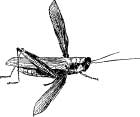
If we are careful, we can spread them out.
We will use this dead grasshopper that Charlie has found.
What pretty wings! So dainty! And how cleverly they are folded up, like little fans.
Who would imagine such delicate gauzy wings were folded away under the hard, stiff roof wings.
The roof wings are called wing covers, because they cover up these pretty inner wings.
The locust does not fly with the wing covers.
It spreads them out wide to get them out of the way.
It flies with the inner wings.
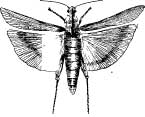
How pretty the flying wings are when they are spread out!
See, over there goes a grasshopper whose flying wings are bright yellow.
And there goes another with red flying wings.
Some of the grasshoppers are almost as pretty as butterflies when they are flying.[Pg 75]
They show their gay inner wings only during flight.
As soon as the grasshopper comes to rest the inner wings close of themselves.
The wing joints act like springs.
The grasshopper does not have to think about shutting up its wings.
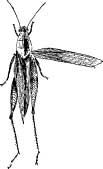
John says it has a spring in its wing covers too.
Open the wing cover.
There, it locks itself, as it were, and stays open without any effort on the part of the grasshopper.
You see the grasshopper wants its wing covers to stay open and out of the way of the inner wings when it flies.
So it just opens them, and there they are.
It moves the inner wings very fast indeed when it is flying. It would not do at all for them to be fastened open.
If it did not move them, it could not fly. The wings fairly whirr, they go so fast. They beat against the air, and thus the grasshopper is pushed along through the air.
As soon as it is done flying it stops moving the wings, and they instantly close of themselves.[Pg 76]

Then it unlocks the wing covers and they shut down over the inner wings. They shut down very tightly. They overlap, as you can see, just below where they are fastened to the insect's body. Thus they form a very good roof.
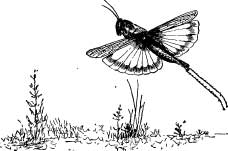
What wonderful wings the grasshopper has!
And there is something more to be said about them.
Some species of locusts use their wings as musical instruments. When they wish to, they rub the upper end of the inner wings against the upper end of the wing covers when they are flying.
This makes the crackling sound we sometimes hear when the locusts fly.
What is that, Mollie? You have caught a locust that has no wings at all?
Who can guess why?
Ah, yes, our wise John says he thinks it is because it is a young one.
What makes you think so, John?
I know, you remembered the larva of the dragon fly and of the May fly.

Those larvæ had no wings at first, but the wings grew, and finally at the last moult they were full-sized.
When first hatched, the locust larva is like the full-grown locust, only, of course, it is very small, and it has no wings at all.
It is a little dot of a thing with an enormous head.
Here are three clinging to a blade of grass.
Are they not funny little rascals!
The baby locust eats and grows and moults until, finally, the wings begin to show as little pads at its sides.[Pg 78]

It is easy to find these half-grown grasshoppers in the middle of the summer.
Here is one that little Nell has caught.
See its wing pads.
Mollie says they are rudimentary wings.
It continues to eat and grow and moult, and the little wings are moulted off with the rest of the skin—for the wings of the insect are only modified parts of the skin.
But there are new and larger wings underneath, and these grow and are moulted off with the next skin, until, at last, the grasshopper is full-grown, with full-grown wings.

It will not moult any more after that.
When full-grown, the females lay their eggs.
Where do you suppose they lay their eggs?
Some of them make a hole in the ground.
The end of the abdomen is very strong and sharp, and the locust can make a hole with it quite easily.
When the hole is made, then the eggs are laid in it, and the locust covers the opening to the hole with a sticky substance to keep out the wet.
The eggs usually lie in the ground all winter.
Just think of the locust eggs there are under our feet as we cross the fields!
Millions and millions of little eggs are hidden in the ground.
Early in the next summer the little eggs hatch, and then tiny locusts creep up out of the earth and go hopping about everywhere.
Most of the full-grown locusts die in the fall.
As you know, the young ones have no wings, and this is why there are so few winged locusts early in the summer.
Some locusts make their holes in fence rails or in old stumps.
It is the locusts, or shorthorned grasshoppers, that sometimes come in swarms that darken the sun.
There is nothing the Western farmer dreads so much as a swarm of locusts.
I have heard how the grasshoppers came in Kansas one year.
They appeared all of a sudden in countless millions.
They were piled up against the fences clear to the top.
They swarmed into the houses, and in places on the railroad track they were piled so deep the trains could not run through them.
Think of a railway train being stopped by grasshoppers![Pg 80]
They stripped every leaf from the trees and left them as bare as in winter.
They ate up every blade of grass.
But in the East they do not do so much damage, though they sometimes cause the farmers serious loss. When summer comes we may listen to their cheery din with pleasure.
I am sure we shall enjoy the merry sounds of the grasshoppers all the more now that we know something about how they are made, and something about the little fellow that makes them.
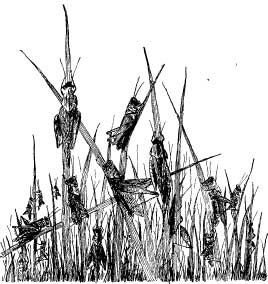
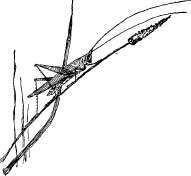
Probably it was the longhorned grasshoppers that Charlie saw so many of in the meadow.
Look, next time, Charlie, and see if the swarms that start up before you have not long, slender antennæ.
See, here is one.
Its antennæ are like threads, and they are longer than its body.
If you were to look at its tarsus, you would find it had four joints instead of three.
Otherwise, the longhorned, or meadow grasshoppers are very much like the locusts, or shorthorned grasshoppers.
John says he thinks the meadow grasshoppers are more slender and delicate in shape.
That is true, as a rule, though there are some species of the locusts that are as slender as the longhorned grasshoppers.
But there is one thing about these longhorned fellows that will amuse you.
Some of them have ears on their front legs![Pg 82]
It is not uncommon for insects to have hearing organs on their front legs.
You know what an ear is. It is something to hear with. The hearing part of our own ears is way inside, out of sight.
The outer part of the ear, that we can take hold of, is only a sort of funnel to gather up the sound, and we could still hear if this part of our ears were cut off.
Way back inside the ear is a little curtain, or eardrum, made of a thin membrane.
When sounds enter the ear they cause the eardrum to tremble or vibrate, and this excites the nerve of hearing that is behind the eardrum.
Now some grasshoppers have a little flat membrane on the tibia of each front leg. It is an eardrum. Behind it is the nerve of hearing. When sounds strike the eardrum it vibrates and excites the nerve of hearing.

So you see the insects have ears, though they have no funnel-like outsides to them.
So, after all, there isn't so very much difference between the way the grasshoppers hear, and the way we hear, although they do hear with their legs.
Yes, Ned, it is about the same thing when they hear with sensitive spots on their antennæ.
The sounds strike the sensitive spots, which are tiny[Pg 83] eardrums, and cause the nerves that come to them to hear.
You see, after all, an ear is only a membrane able to vibrate when sounds strike it and a nerve sensitive to those sounds.
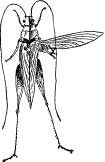
It does not matter much where the ear is located. Our ears are on either side of our head, and so are the ears of all the higher animals.
But the ears of the insects are more useful to them when on the antennæ, or the legs, or some have them on the abdomen. An ear is an ear wherever it happens to be, and the insects hear well enough with theirs.
In many species of the longhorned grasshoppers, the male has a curious musical instrument on his wing covers, close to where they grow from the body.
Little Mr. Grasshopper sings to his lady-love by rubbing the upper parts of the wing covers together. You see the round places at X,—those are the modified parts of the wing cover, by means of which he can make his music.
What is that, May? Your grasshopper has a long sword at the end of its body?[Pg 84]

Yes, that is its ovipositor. Ovipositor means "egg-placer."
With this long, sharp ovipositor the grasshopper can roughen the bark of twigs or make holes in the stems of plants or in the earth.
Then the eggs are guided down through the long ovipositor to the place prepared for them, and fastened there by a gummy substance.
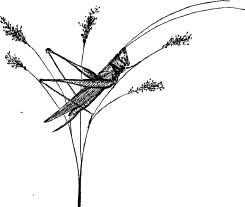
Only the female grasshoppers have the long, sword-shaped ovipositor.
The ovipositor of the locust is not long and sword-like.
It is short, but it is strong and sharp, and you remember how the locust uses it to dig with.
Yes, indeed, Mollie, there are a great many species of locusts and grasshoppers, and some of them are very beautiful.[Pg 85]
In hot countries they sometimes grow to an enormous size.
May is asking why they make molasses.
No, Ned, of course it isn't molasses. Children call it molasses because it looks like it.
Now, May, where does it make its molasses?
In its mouth, you say, and then it spits it out on your finger.
What? You don't like its old molasses on your finger?
No, of course not.
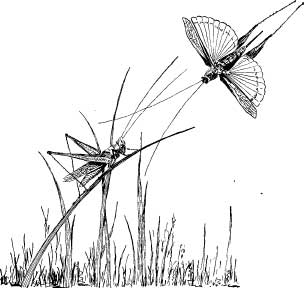
It smells bad, and it is sticky and disagreeable to the touch, and if you happen to put your finger in your mouth it has a nasty taste.
John says he hates to touch the grasshopper on account of this molasses.
You all do?
Well, I guess that is why it makes its molasses; it doesn't want you to touch it.
It doesn't want birds to eat it, or other insects to bother it, and so it smears them with this ill-smelling, sticky liquid.
Some birds eat it, however, in spite of its molasses.
Turkeys do.
What is that, Ned? turkeys are not birds, you think?
What are they?
If you think about it, you will have to come to the conclusion that turkeys are birds.
Then chickens and ducks and geese must be birds?
Well, so they are. They are all birds.
But to return to turkeys.
A flock of turkeys will spread out in a long line, and go across a field, driving the grasshoppers ahead of them, and eating them as fast as they can pick them up.
It is a funny sight to see a big flock of turkeys hunting grasshoppers in a meadow.
It is not funny to the grasshoppers, though.
What is that, Charlie? The grasshopper somehow reminds you of the praying mantis?[Pg 87]
Do you know it is a near relative of the mantis?
Now, I will tell you something funny about the mantis.
It makes "molasses" like the grasshopper. Yes, it is this harmless "molasses" that has given it the name of "mule-killer."
I will tell you something else. If you lie down in the grass and watch the grasshoppers, you will have a good time, and you will see some strange things.
Nobody can tell you very much about the grasshoppers—or about the living creature. The best way is to use your own eyes and watch.
Just lie down in the grass perfectly still, and soon the insects that live in the grass will begin to appear.
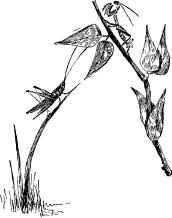
What they will do you must find out for yourselves; but you may be sure it will be worth finding out,—the funny, clever, wise little people!—ah! they are good to watch.
They will soon go on chirping and shrilling and rasping and kricking and tapping and whizzing and whirring and buzzing all about you; and if you listen sharp, perhaps you can understand some of the things they say.[Pg 88]
And this I am sure of; if you really watch and listen, you can learn to know the different insects by their sounds, just as you can know the birds by their songs. You can even tell whether you are listening to the meadow grasshopper, or the locust.
If I thought you were not tired of hearing how grasshoppers are made, I should tell you some more.
John says he would like to know some more.
Well, then, I will tell you about their rings.
You can see the rings of the grasshopper people very plainly in their abdomens.

Here is a picture of a grasshopper. It is not all drawn. The legs and wings are not shown, and the abdomen is drawn by itself so you can see it easily.
There are ten rings, you see.
The rings are covered with a hard, horny substance.
This horny substance is what makes the body of the insect so stiff. It would be soft but for the chitin, as the horny substance is called.
It is better for the insect to have a chitinous covering.[Pg 89]
If you had no bones, you would be glad to have your skin hardened with chitin.
You see how it is, you wear your skeleton inside. Your skeleton is of bones; it is an inside skeleton.
The grasshoppers and all the insects wear their skeleton outside. It is made of chitin; it is an outside skeleton.
Insects have no bones.
They do not need any. They are kept stiff by the chitin.
Each ring in the insect's abdomen is made of four pieces, the back piece, the side pieces, and the under piece. You can see the back piece and one side piece in the picture, but you cannot see the other side piece nor the under piece without turning the insect over.
The rings are made in pieces so the insect can move.
Suppose each ring were made of one stiff piece like a finger ring. What a poor stiff, old grasshopper it would be! The rings are called segments.
Segment number one has only a back piece, you see.
All the other segments have four pieces.
Segments two, three, four, five, six, seven, and eight are alike.
Segments nine and ten are modified to form the ovipositor.[Pg 90]
The segments are fastened together by skin. The skin is soft so the segments can move back and forth.
The segments can be crowded close together to shorten the abdomen.
The segments can be separated from each other to lengthen the abdomen.
There is no chitin in the skin between the segments. It is soft so the segments can move.
Do you know how a telescope is made?
The abdomen of the insect can lengthen and shorten somewhat like a telescope.
It is easy to see the rings in the abdomen of the locust or grasshopper.
Now, what about the thorax?
That, you tell me, has no rings.
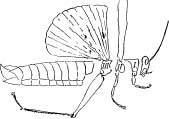
Look again, and look carefully.
You will have to see another picture.
This is a picture of the head and thorax of the grasshopper. It is drawn to show the separate parts of the thorax.
Yes, John, the thorax has three segments. They are grown so close together you would not suspect it until you looked very close.[Pg 91]
The front legs are fastened to the first segment.
What is fastened to the middle segment?
Yes, May, the middle pair of legs and the wing covers.
Mollie says the long hind legs and the flying wings are fastened to the third or hind segment.
Oh, you funny little folks! you are all made up of rings.
Yes, indeed, little Nell, the segments of the thorax are made of chitin; they are very stiff.
Ned thinks the segments of the legs are made of chitin too.
Their outside shell certainly is.
The whole outer shell of the insect is made of the horny chitin.
You hard little chitin-covered, segmented people, you are very different from us.
Ah! yes, May, they are like us in many ways.
Indeed, Mollie, insects do have brains.
They have muscles, too, to move their little bodies with.
We have muscles under our skin, you know. The muscles move our arms and legs and bodies.
If you clasp your fingers around your arm and then move your arm, you can feel the muscles.
The insects have muscles inside their chitinous shells. The muscles move their bodies.[Pg 92]
The muscles are very, very strong.
They are stronger for their size than the muscles of a horse.
John, do you know how heavy a load a horse can pull?
Well, it cannot pull a load equal to the weight of its own body.
Now, listen to this,—almost any insect can pull a load that is five times the weight of its body!
Ah, yes, some insects can pull a much heavier weight than that. The honey bee, for instance, can pull a load twenty times as heavy as its body.
And think how our little insect friends can jump! Why, a kangaroo cannot begin to jump like a grasshopper.
No, indeed, Ned, the finest jumper in the world of men cannot begin to jump as well as a grasshopper, not even with the aid of a spring board. He is a mere baby in comparison.
Ah, yes, we can do a great many things better than the grasshoppers, but, you see, they can do some things better than we can.
What is that, John?
You want to know about the mouth parts of the grasshopper?
Suppose we leave the mouth parts.[Pg 93]
They are difficult to understand. We have had a good many new names to learn lately.
What, May? You can't remember such hard words?
Oh, yes, of course you can.
You don't mind learning "rhinoceros," and "Mississippi," and "Popocatepetl," and "eenie, meenie, monie mike," and they are quite as hard as femur and tibia; and, besides, you have a femur yourself! Did you know it?
Your thigh bone, like the grasshopper's thigh, is called a femur.
Yes, Mollie, there is a bone in your leg called the tibia, and you have a tarsus in your foot.
So, after all, when you are learning hard words about insects you are learning a great deal besides, as you will find.


Katy did!
Katy didn't!
Katy did!
Well, well, did she or didn't she, and what of it anyway.
Come here, Katy did and Katy didn't, the children want to see you.
She's a pretty little Did and Didn't, isn't she.
Katy, why do you not know your own mind and always tell the same story?
Krick—krick—krick, there, she is talking; that's her way of saying "Katy did."
Krick—krick—krickkrick. Now she has said "Katy didn't."
Well, we never shall know anything more about it.
No, little Nell, she doesn't really say Katy did or Katy didn't, but it sounds like that, and we make believe she says it.[Pg 95]
John says he is sure the katydids are first cousins to the grasshoppers and locusts, and so they are.
They are very closely related to—which division of locusts, do you think?
Oh, yes, the longhorned, of course.
See their long, long antennæ, and the male has the same little musical places on his wings, little membranes that vibrate and make his song of Katy did and Katy didn't.

No, the little lady katydid cannot sing—only the little male, and he keeps it up all night long.
We sometimes wish he would get tired or sleepy and stop, but he never does.
Why do you suppose he likes to sing so well in the night?
The katydids generally live on trees and bushes.
Yes, they are a beautiful, pale green people, and that is one reason we do not often see them. It is not easy to find a katydid among the green leaves.
The female katydids have a long sword-[Pg 96]shaped ovipositor with which they roughen the bark on twigs, and place the eggs there, fastening them with a gummy substance.
The egg is glued fast so it will not fall off.
It hatches into a little dot of a katydid that has no wings, but, like the larvæ of the other insects we know about, it eats and grows and moults, and at last its wings and the rest of its body are full grown.
It casts its skin for the last time; it is no longer a larva, but a full-grown insect.
Yes, May, we call the young of all insects larvæ.

See this dainty katydid that Charlie has caught for us.
How pretty it is!
Its feelers are like long green threads.
And how sensitive they are!
It quickly starts away when we touch one of the feelers.
Yes, Mollie, the katydid walks more than the grasshopper.
It can jump well with those long, slender hind legs. How beautiful its hind legs are! They are longer and more delicate than those of the grasshopper.
And its wings, how gauzy and dainty! Its wing covers are not so stiff as those of the grasshopper.[Pg 97] They look almost like flying wings, they are so delicate.
See, they open, and fasten themselves open, like the wing covers of the grasshopper; and when they are at rest they overlap like the wings of the grasshopper.
The inner wings are like fine lace.
They look too delicate for use, and yet the katydid flies very well indeed with them.
They are a little longer than the wing covers.

When the katydid is at rest you can see the tips of the wings extending beyond the ends of the wing covers.
The part of the inner wing that extends beyond the wing covers is green, like the wing covers, you see.
But the rest of the inner wing is not green, it is like very thin glass, or like fine isinglass.
Look for a moment at the long curved ovipositor of the female katydid.[Pg 98]
If you look sharp, you will see teeth on it like a little saw. It is with these teeth the little katydid is able to rasp the surface of the twigs, and make a place to fasten her eggs to.
Her wings are wrapped about her form like an ample cloak of green.

Now, my little katydid, you may fly away if you want to.
We are very much obliged to you for letting us look at you, and we hope we have not troubled you too much.
See her go!
How prettily the katydids fly.
They seem almost like little birds.
I am sure they love to fly about in the bright summer-time.
Happy katydids.[Pg 99]

Now what strange-looking little creature are you?
John says it looks like a grasshopper, only it has no wings and its body is not that of a grasshopper.
May says it looks like a cricket, only it has the long legs of a grasshopper.
It is called the cricket-like grasshopper, and it is partly like a cricket, as you see, and partly like a grasshopper.
It is a funny little fellow that lives around in dark corners, usually in the woods.
Do see those long, spiny legs!
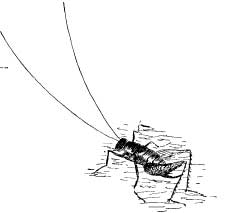
How he can jump.
He has strong, short, sharp spines on the femurs and on the tibias.
He has spines on all his legs, and what long feet he has!
Yes, Nell, his antennæ are longer than[Pg 100] anything else about him. I should think they would be in his way.
He has no wings at all, and he never will have any.
He has two pairs of feelers in front of his mouth that show very plainly. They show more plainly than the mouth parts of the grasshopper, though they are quite like them.
Yes, Ned, they are larger than the mouth parts of the grasshopper.
There is another little fellow very similar to the cricket-like grasshopper.
It has no wings, and the top of the thorax is like a broad shield.
It is called the shield-backed grasshopper.
See if you can find one of them.

Chirp! chirp!
Chirp! chirp!

Ah, listen to that cheery song. It is the cricket on the hearth singing thus gayly.
Dear little cricket; he lives in the corner by the fireplace. When all is still we hear his cheery chirp! chirp! chirp!
Sometimes he comes peering out and runs across the hearth, a little black fireside fairy.
Do you know one of the prettiest stories in the world has been written about a cricket?
Charles Dickens wrote it, and it is called "The Cricket on the Hearth."
Be sure to read this beautiful story. If you do not own it, ask to have it for Christmas. It is in the book of "Christmas Tales," a book that everybody ought to have.
Grasshoppers and katydids are pleasant people, but they live out of doors, and they do not seem quite so much like our very own little friends as the crickets.[Pg 102]
Of course the crickets live out of doors, too, only once in a while one of them comes into the house to live with us.
We hear them chirping in the grass and among the stones.

There is a certain place near the seashore where the rocks are alive with the black cricket folk.
They come peeping out at you from all sides. They skip over the rocks, and you will often see a pair of long feelers and an inquisitive little head looking around a corner.
You too, know there are crickets, little Nell?
Let us go and see them.
Ah, yes, there is one, looking at us out of inquisitive eyes, over there by that big stone.
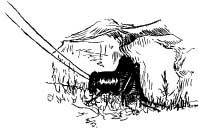
Of course they are cousins to the grasshoppers. I knew you would guess that right away.
Yes, John, the little cricket people have flat backs.[Pg 103]
Their wing covers do not make a peaked roof over their backs, but are flat on top and bent down at the sides like a box cover.

They are not so long as the wings of the grasshopper, but they overlap on top.
Sometimes they are not so long as the body of the cricket.
Just watch now!
How spry the cricket folk are!
They jump well, but they also run well. They are always running about as though they enjoyed it.
It is not easy to catch one of them unless we, too, are "as spry as a cricket."
Funny little rascals, to come peeping at us like that, from out the crevices in the stones.
When we stir,—pop! they are back out of sight.

They eat leaves, and they enjoy a piece of nice, ripe fruit, or a bit of juicy vegetable.
See here, one has jumped on my hand and is sitting quite still.

It is a male cricket.
How do I know that?
May says because it has no ovipositor.
Yes, that is one way to know.[Pg 104]
Look at his wing covers.
See how they are ribbed.

Now look at this cricket Mabel has caught. It is a female, and its wings, you see, are not ornamented like those of the male.
Do you know the meaning of his heavily ribbed wing covers?
Why, his wing covers are his musical instruments. See one of them magnified.

It is divided into spaces like so many little drum-heads. The ridge that runs across the top of the wing is something like a file in structure.
When little Mr. Cricket is in the mood for chirping, he raises his wing covers and rubs them together.
This throws the stiff membranes of which the wing covers are made into vibration, and the result is the cheery call of our little black fairy.
Little Nell says the cricket is more like a brownie than a fairy, and maybe she is right.
You can easily see the crickets rub their wings together if you watch in the fall of the year.
John says, Why do you have to watch in the fall of the year?
Now who can guess?[Pg 105]
Yes, May, it is because the crickets are then full-grown, and have large wing covers. At first, in the early summer, they have no wings, and so of course, we could not see them chirp.
The whole grasshopper tribe is a vocal one; the males all have musical instruments, and in Japan, the people are so fond of the song of their grasshopper folk, which are not quite like ours, that they make tiny cages for them.
The chirpers are caught and put in these cages, and sold in the city streets.
Yes, little Nell, the crickets make molasses. So do the katydids.
All these little hopping neighbors of ours seem to understand the useful art of molasses making.

The mole crickets are different from the others.
They burrow in the ground like a mole, and we do not often see them.
The strangest thing about them is their hands.
No, of course they are not really hands, but they look like them.
All the joints of the fore legs are modified to form strong digging tools, and they look very much like the paws of the mole.

They are troublesome fellows, sometimes, when they eat the tender roots of the vegetables in the garden.
You all have seen the little tree cricket, but you might not recognize it as a cricket, it is such a pale little creature.
Its light green body may often be seen on bushes in the summer-time, and, if you look carefully, the form will tell you what the little one is.


The crickets, grasshoppers, walking sticks, praying mantes, and cockroaches, strange as it may seem, are all near relatives to each other.
They all belong to one large family or order, the Orthoptera.
Or-thop-te-ra, is it not a hard word!
It will not seem so hard when you know what it means.
It comes from two Greek words orthos, meaning straight, and pteron, meaning a wing.
Straight-wing.
And do you know, it does not mean that the upper wings are straight, but that the under wings are folded down in long straight lines.
Now let us see if we can tell in what ways all of our Orthoptera are alike.
They all have—?
"Four wings"—that is right, little Nell.
What, John? the walking sticks have no wings?

Not our walking sticks, but yet they belong to a winged family. You remember the tropical walking sticks that have queer leaf-like wings, do you not?
Are the four wings alike?
No, John says, the upper ones are narrow and stiff and serve as wing covers.
The inner ones are broader and more delicate. They fold up when not in use and are used to fly with.
Very good indeed, John. Now I will tell you something. The Orthoptera all have mouth parts made to bite with. They do not bite anything but what they eat, however. They are quite harmless so far as we are concerned.
The young Orthoptera look like the old ones, only they have no wings. They hatch out of the egg with a head, a six-legged thorax, and an abdomen.
Now, come, let us look at all of our orthopterous friends again, cockroaches first.

How do they get about, John?
Yes, indeed, they run, the rascals. They run fast too. They are flat and their six legs are very much alike. They are well built for running and hiding in cracks.
Suppose we call them the Running Orthoptera.
Now, look at our mantis.[Pg 109]
He does not run very much. How is he different from the others?
Ah, yes, he has big front legs, and little Nell says he grabs things with them.

So he does. Now, what shall we call these grabbers?
The Grabbing Orthoptera, Ned says.
Suppose we say instead the Grasping Orthoptera, because grasping sounds a little better than grabbing. Do you not think so?

Now for Mr. Walking Stick.
We cannot very well call him a member of the Running Orthoptera, can we?
Ah, Mollie has it. We must call his kind the Walking Orthoptera.
His six legs are all long and slender, and he moves them slowly.
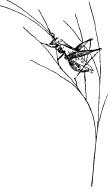
Now for those fellows with the long hind legs, the locusts and katydids and crickets. Yes, all of you are ready to name them.
We call them—what?
May says, the Hopping Orthoptera.
John thinks Jumping Orthoptera would sound better.
And that is what we name them, the Jumping Orthoptera.
How many kinds of Jumping Orthoptera are we[Pg 110] acquainted with, Ned? Now, think before you speak.
He says we know the shorthorned grasshoppers, or locusts, the longhorned, or meadow, grasshoppers, and the crickets.
Very well done, Ned.
May wants to know what has become of the katydids and the cricket-like grasshoppers—she thinks Ned has left them out.
Ned says they belong to the longhorned grasshoppers.
Now you shall have a list of the Orthoptera that will help you to remember them.
If we can group together things that are like each other, it is easier to remember them.
Order Orthoptera.
Running Orthoptera.
Cockroaches, Croton Bugs.
Grasping Orthoptera.
Praying Mantis.
Walking Orthoptera.
Walking Sticks.
Jumping Orthoptera.
Shorthorned Grasshoppers, or Locusts.
Longhorned, or Meadow, Grasshoppers.
Crickets.
[Pg 111]
There are a great many species of Orthoptera in the world, and we have seen but a very few of them.
But I can tell you, we feel a little better acquainted with you orthopterous fellows than we did.
The dragon fly says we have not given him a place.
But, dear dragon fly, you belong to another family. You are not an orthopterous insect.
Your order is called the Odo-na-ta.
The wings of the Odonata are very different from those of the Orthoptera.

You remember how they are?
Yes, Ned, they are stiff and covered with a close network of fine veins, and all four of them are alike.
No wing covers, you see.
I do not know why they have the name Odonata.
The young Odonata are not like their parents, excepting that they have a head, a thorax with six legs, and an abdomen. But they certainly do not look like their parents!
No, John, the May flies do not belong to the Odonata. Their wings are quite different.

Do you not remember how small the hind wings are?
The name of their order is Eph-e-mer-i-da.
There is a big name for a little insect![Pg 112]
It comes from the Greek word ephemeros, and you know what it means.
What? Has everybody forgotten about the dainty little ephemeræ, that live but a day?
That is what ephemeros means, lasting but a day.
The stone flies have four wings, but they are not like those of the Odonata, or of the Ephemerida.
Do you remember how the hind wings are folded?
Yes, May, in plaits, so these are the plaited wings, or Ple-cop-te-ra, from pteran, a wing, and plecos, plaited.
The little silver fish, as you remember, has no wings at all, so its order is called Thy-sa-nu-ra, from its bristle tail, thysanos, in Greek, meaning a tassel, and oura, the tail.

Now, my children, do you know what a bug is? Most people do not.
They call every insect a "bug," but bugs are bugs, flies are flies, ants are ants, and neither flies nor ants are bugs.
Indeed, no insects are bugs—excepting just bugs!
Our croton bugs are not really bugs. They do not belong to the bug family.
A bug has four wings—when it has any.
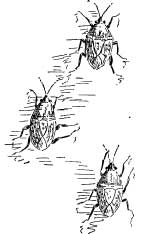
But its wings are not like those of the Orthoptera or Odonata or Ephemerida or Plecoptera.
Some bugs have no wings.
Young bugs are like old bugs, only smaller, and they have no wings.
You remember the Orthoptera and Odonata bite their food.
They chew it up and swallow it.
Bugs do not bite, they suck. Their mouth[Pg 116] parts are often grown together in the form of a tube that is sometimes very sharp.
They stick these sharp tubes or beaks into their food, and suck it up.
What, May; you want to see a bug? Well, that is easy enough.
Here is one in this pond at our feet. Do you know it?

Yes, John; it is the water boatman.
Nell says she doesn't see it.
There, Nell, that little thing that shines like silver under the water. It is clinging to a weed.
No, we cannot see it very well unless we catch it.
Ned, do you think you can be spry enough to scoop it out with the net?
There, he has it,—no, it is off.
Well, we shall never see that one again; but here, in this corner of the pond, see, several of them.
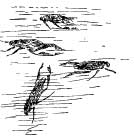
Now don't be in too great a hurry, Ned; they are hard to catch.
He has it!
Here, don't touch it,—bugs are biters, remember.[Pg 117]
Put it in this tumbler of water, and clap the cover over it—quick—so!—now we have it.
What is that, Mollie? I just said bugs do not bite, and now I call them biters?
I don't wonder you are puzzled.
They do not bite, but they pierce with their mouth tubes, and that feels just as though they bit us. So we commonly speak of bugs as biting.
If you wish to be very exact, we will hereafter speak of bugs as piercing or sucking.
Now, Mr. Water Boatman, we are going to have a good look at you.
Nell says it is not like silver any more, but just a little black and gray speckled bug.
That is because it is now on top of the water. When it goes under it is surrounded with a layer of air, and that is what makes it look as though it had on a silver dress.
May wants to know how it manages to take a layer of air down under the water. If you were to look at it with a magnifying glass, May, you would see it is covered with fine hairs; the air becomes entangled in these hairs. Do you not remember how the leaf of the jewel weed, or touch-me-not, as it is also called, shines when you plunge it in water? It, too, is covered with fine hairs that hold air. Many leaves shine in this way[Pg 118] when put under water, and always because of the fine hairs that prevent the air from being pushed out by the water. You see the hairs on the bugs serve the same purpose as those on the leaves; they hold fast the air.
Our water boatman breathes this air that surrounds him.
You know how insects breathe do you not?
Dear me, then I shall have to tell you.
They have no lungs; of course, so they cannot breathe with lungs as we do.
Take a long breath—see how your chest rises—that is because you filled your lungs full of air.
Well, the insects have to breathe air.
Every living thing has to breathe air. Nothing in the world could live without air.
Even plants breathe the air, you know.
Now, there is a little row of holes or pores along each side of the abdomen of the insect.
These are the breathing pores. No, May, the insects do not breathe through their mouths, they breathe through their sides.

You can see the breathing pores, or spiracles, as they are called, very plainly in many insects.
You can see them on the abdomen of the locust, and in some caterpillars they are bright-colored spots.
There are spiracles on the sides of the thorax, too, but they do not show so plainly as those on the abdomen.
The spiracles open into air tubes that carry air to the blood of the insect.

If you watch a grasshopper or a bee, you can plainly see it breathe. The abdomen moves in the bee as though it were panting. These movements of the abdomen cause the air to go in and out. All insects move their abdomens to send the air in and out, but it does not show plainly in all of them, for, though insects need air, some of them can get along with very little.
Yes, John, insects have blood. It is not just like our blood, but still it is blood.
It is not generally red in color, though sometimes it is reddish, and sometimes it is brown, or violet, or even bright green.
Yes, that seems strange to you, but you remember how ears are ears, and serve to hear with, no matter where on the body of the creature they are located.[Pg 120] So blood is blood, and serves the purpose of blood, no matter what its color. The blood of some insects has a very bad odor, and in the case of certain beetles, when they are disturbed, this foul-smelling liquid oozes out of the joints of the legs.
Yes, Mabel, it is probably used, like the "molasses" of other little friends we know, to repel enemies.
But to return to breathing. Some larvæ breathe by gills, and do not have spiracles until they are grown up, but all grown-up insects breathe by spiracles.
Yes, John, the larvæ of the dragon flies and May flies breathe with gills.
I thought you would remember that.
The water boatman breathes by spiracles, and carries his supply of air with him. All grown-up bugs breathe by spiracles.
Now look down into the pond. I think you will see some water boatmen anchored near the bottom.
Yes, May, they cling by their front feet. Their hind pair of legs are rather odd-looking; they have a fringe of hairs on the inside.
John says their hind legs are modified to swim with.
Very good, John.
The hind legs are the oars that row these little boats about in the water.[Pg 121]
But why are the little boats that have come to anchor down there moving their paddles so constantly?
Ah, yes; it is because they want fresh air to breathe.
You know there is always air in pond water, and they keep their paddles moving, so as to change the envelope of air that surrounds them.

They know what to do to take care of themselves, if they are nothing but little bugs.
When winter comes, they go down to the bottom of the pond and bury themselves in the mud. They lie there without moving or breathing until spring, when out they come, as lively as ever.
Yes, certain other animals pass the winter in this way; the bears, for instance, find a snug den and sleep all through the coldest winter weather. We call this winter sleep of animals hibernation, and many of the insects hibernate.
Yes, Ned, hibernating animals can get on with very little air; they sometimes seem to need none at all, and they take no food.
May wants to know what these queer water boatmen eat.
They suck out the juices of other insects.[Pg 122]
They must lay their eggs in the water, little Nell thinks.
And so they do, on water plants.
Near the city of Mexico there are species that lay enormous quantities of eggs in the ponds, and what do you think? The Indians mix these eggs with meal, make them into cakes, and eat them.
The Mexican bugs are gathered by the ton, too, and sent to England as food for cage birds, fish, and poultry.
Little Nell thinks there must be a great many bugs in a ton. Indeed, there are, probably about twenty-five millions of them; so you can imagine Mexico is well supplied with water boatmen!
When the young ones hatch out they look like their parents, only, of course, they are tiny little dots of things that have no wings.

But they eat and grow and moult like other larvæ until they are full-grown insects.
What have you discovered, Ned? You look surprised.
The water boatman has no antennæ!
It doesn't seem to have any. But look carefully and I think you will find some tiny ones tucked away under its head.
Nell wants to know if the water boatman has a thorax and an abdomen.[Pg 123]
Indeed, it has, but you will have to look carefully to see them. Its abdomen is short and thick and hard. The water boatman is much more compact in form than the Orthoptera, or any of the other insects we have studied.
You are right, John, an insect with a long abdomen, like the grasshopper, could not get on very well in the water.
Now, May, take the cover off the tumbler. There!
Our water boatman was not slow to make use of his wings.
Well, good-by and good luck to you, little water boatman.

What, John? You know a water boatman that swims on its back?
That makes Nell laugh, and no wonder.
Yes, there is a little bug that swims on its back.

It is very much like the water boatman, and it has long paddles made of its queer hind legs.
Unlike the water boatman, however, its back is not flat but is shaped like the keel of a boat.
This being the case, it just turns over and swims with its keel-shaped back in the water.
It is sometimes called the back-swimmer, and most boys are well acquainted with it.
What do you think about catching it in your fingers, Ned?
Ah, you do not like to!
It has a very sharp beak for sucking the life out of other insects, and if you succeed in getting hold of it, it will stick that into your finger.
And my! how it does sting!
It is not an easy matter to catch it, however,—it is such a quick little rascal.[Pg 125]

A good many kinds of bugs live in the water, but perhaps the oddest of all is the giant water bug.
It is a giant!
Have you ever seen very large, flat brown bugs lying on the ground under the electric street lamps?
Those are the giant water bugs.
They fly in the night from pond to pond, and are attracted by bright lights.
They fly into the electric lights, and are killed in great numbers sometimes.
This is such a common habit with them that in some places they are called electric light bugs.

A good many people never saw these bugs until they[Pg 126] were found dead under the electric lights, and so they imagined they did not exist until electric lights were invented.
But that is a very foolish notion; the bugs were here thousands of years before electric lights were dreamed of.
The giant water bugs are not pleasant to handle when alive.
If you ever succeed in catching one in the water, which is not easy, they slip about so quickly, be sure and not take it in your fingers.
The California children call a species they have there "toe-biters," and they say they bite their toes when they go in wading.
The giant water bugs are the largest of living bugs, and they even kill and eat fish.
Their fore legs can shut up like a jackknife. The tibia shuts into a groove in the femur, and thus the bug is able to seize and hold its prey.
It clasps its victim in its arms, as it were, and calmly proceeds to suck out its blood.
In some species of the giant water bugs the female does not leave her eggs in the pond to take care of themselves; she puts them on the back of her mate, who is obliged to carry all of his progeny about with him until they relieve him by hatching out and swimming off to see life for themselves.[Pg 127]

May says she wants to hear more about bugs. Well, there is little Mrs. Shore Bug. I think you must all know her.
She is the little bug that flies along in front of you on the seashore, or, indeed, on the edge of any body of water.

She flits along just in front of you, and is so quick in her motions that you will hardly ever catch her.
She does not fly far—she alights just far enough ahead to make you try again to capture her, but when you think you have her, she isn't there!
She has sped off on one of her short flights, and so she will continue to do as long as you continue to chase her.

Then there are the water striders.
They are bugs, and it is easy to guess how they got their name.
You surely remember the longlegged, dark colored fellows that straddle about on top of the water, in ponds or in still pools in streams?[Pg 128]
Who has not tried to catch them!
And how very seldom any one succeeds!
May knows where we can see some water striders close at hand.
They are on the pond in the meadow. Let us go.
Ah, you little ones! There you are, scampering over the water on your airy, fairy feet, as though you were on dry land.

How they flash about! And what cunning dimples their little feet make on the water when they stand still!
If we keep very quiet, they will stop darting about in that wild way, and we can see them better.
Now, water striders, why do you behave so, and what do you eat?
Eat? Why, insects, of course. And as to behavior, they may well wonder more at ours than we at theirs.
They skate about on the surface of the water all summer, and when winter comes they hide away at the[Pg 129] bottom of the pond, right under the water, or along the edges of the banks.
When the warm spring sunshine wakes up the sleeping plants, then the little water striders wake up too.
Out they come, to resume their endless skating and insect catching, but now they lay their eggs, gluing them fast to water weeds.
The young water striders look like their parents, and they, too, like to go circling and flashing over the top of the water, with their long legs spread out.
What do you suppose is in this box?
Little Nell may open it.
There, out he comes—slowly, as though he were looking around and thinking about it.

May says, "Hello, Mr. Walking Stick, you here again?"
Ho! ho! is it Mr. Walking Stick?
You look again.
Mollie thinks, if she were going to name it, she would call it Mr. Walking Threads.
Yes, it is more slender than even the walking stick.[Pg 130]
What is that, John? You thought insects had six legs, and this has only four?
Now, here is something for us to think about.
Ned says it has six long threads that might be legs, but it does not walk on the two front ones.
It seems to use them as antennæ.
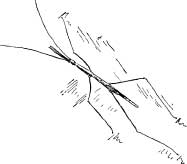
Ned says those front ones look to him to be jointed just like the others, and he thinks they are legs.
Mollie says they have no little feet like the others, and she thinks they are antennæ.
Well, well, what are we to do? Think of its having feelers that look like legs or legs that look like feelers, so that you cannot tell which they are!
Now it is beginning to move, and—Oh, ho, that long part in front is not its head!

See, it separates into two—what?
Surely, two front legs.
See, they were folded up, somewhat like the front legs of the mantis, only these could fold close together, being threadlike.[Pg 131]
So the long threads are antennæ after all.
Now it has raised its head, which we easily see is quite round, with tiny eyes, and the antennæ are growing out from the front of it.
What is it? A walking stick? A mantis?

Why! why! There it goes, sailing off in the air with a queer little fluttering motion of its whole body.
It has wings!
John has caught it and brought it back.
Now let us see those wings, you strange little creature.
You will have to look close, but there they are, narrow, short, such tiny wings! How do you suppose it flies with them?
You seem queerer and queerer the more we look at you, little what-shall-we-call-you.
But we know you are not a walking stick because our walking sticks have no wings.
The truth is you are a—bug!
Yes, this little threadlike creature belongs to the same order as the big flat giant water bug.
It grasps its victim, in its fore feet like the mantis, but instead of biting its prey it sucks out the juices.
You would hardly expect such a delicate creature to catch and kill other insects, yet such is the case.[Pg 132]
No, I do not think it will pierce your finger with its beak. I have often handled them, and have never been stung by one. We often see them walking about in the grass and along paths.
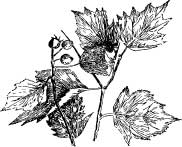
If we pay a visit to that hawthorn bush we shall probably find a bug to our liking. Yes, here is one.
It is a tiny thing, I know, but wait until you see it under the microscope.
Ah, I thought you would be pleased!
Nell says it looks as though it had on a lace party dress.
Is it not a dainty fairy![Pg 133]
We call it the lace bug.

It does not suck the juices of other insects, but instead it sucks the juices of plants.
Its eggs are very curious. It lays them on leaves and glues them fast. They look like little out-growths of the leaf.
The young lace bugs are like their parents in form, only, of course, they have no wings and so they are not pretty.
Fairy lace bug, we are glad to make your acquaintance.

Now, here is a bug we all loathe. It is round and flat, and reddish brown in color, and it has a disgusting odor.
But though we hate this bug, it is very fond of us. It has a short, sharp tube folded down under its head, and this tube it likes to raise up and stick into the skin of people, and suck out their blood.
It has no wings, only a pair of little scales where its wings should be. Yes, May, these scales are rudimentary wings, and they are good for nothing. It once had[Pg 134] wings, but it preferred to go slipping about in cracks and hiding in beds, until in course of time no wings grew, which served it right.
It has antennæ and eyes and spiracles; indeed, it has everything a bug should have but wings and good manners.
We call it the bed bug because its favorite home is in beds, so that it can sally forth at night and feast upon its sleeping victims.
It lays its eggs in cracks and crevices, and each egg is like a little jar with a rim and a lid at the top. When the young one hatches it pushes off the lid. The young are in shape like their parents, only they are very light colored, and almost transparent. They look like ghosts of bugs, but they are very voracious ghosts indeed, and they eat and moult and grow and become darker colored until they reach maturity.
One strange thing about them is that they can live a very long time with nothing to eat, so that houses long vacated may still contain these nuisances, that sally forth, eager to round out their emaciated forms at the expense of the new occupants of the house.
The barn swallow is sadly afflicted by a species of these unwelcome visitors to its nest, and the poor bats are also victimized by a species of bed bug.
The bad odor comes from a liquid poured out of the[Pg 135] back of young bugs, and from the under side of old ones.
These insects are very undesirable acquaintances, and they breed so fast that even one, brought into a house, may cause it to become generally infested in a few weeks.
Eternal vigilance and great cleanliness are the housekeeper's only safeguards.
There are some species of bugs that closely resemble the bed bugs, only they have wings, and live on flowers or in the cracks of the bark of trees.

There are a great many kinds of bugs on the leaves and flowers in summer, and some of them do much damage by eating the vegetation.
One of the most troublesome of these is the red bug. Here is a picture of one.
Its wings look as if they had an X drawn on them.
Let us spread out one of the wings.
Why do you all laugh?
Sure enough, Ned, how can we spread out the wings of a bug in a picture?

But there is a way out of that difficulty.
Yes, another picture.[Pg 136]
Only the upper wings are spread out.
You see, the half of the wing next the body is stiff like a wing cover, and the other half is thin and silky, and folds up under the stiff part. When the insect flies it spreads out the under wings, too, for there is a pair of thin, flying wings folded on the body under these upper wings.
These upper wings, that are half wing cover and half flying wing, are characteristic of the bug order.
Not all the bugs have them, but a great many have.
The name of the bug order is Hem-ip-tera, meaning half-wing. You see why.
Yes, John, the word "hemiptera" comes from two Greek words, hemi, meaning half, and, as you know, pteron, meaning a wing.
The young red bugs are like the old ones, excepting in color.
What do we call the young of insects, little Nell?
Yes, we call them larvæ. These red bug larvæ are bright red with black legs.
They pierce the cotton plants in the South, and suck out the juices.
Of course, they grow and moult until they arrive at the adult form.
What, John? You do not know what "adult" means? Adult means "grown-up."[Pg 137]
It is a short way of saying grown-up; and after this, when we mean a grown-up insect, let us say an adult insect.
To return to the red bug. When it reaches the adult state, it is not such a bright red, but rather of a reddish color with brownish wings striped with light yellow.
Beside eating the juices of the cotton plants and thus injuring or even killing them, the red bugs stain the white cotton and spoil it.
They are also troublesome in some parts of Florida, where they pierce the skins of the oranges, and cause the fruit to decay.
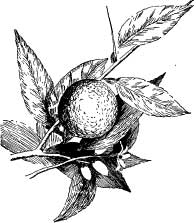
There are a great many bugs injurious to vegetation, among them the little chinch bugs.
They are so small, each one no larger than a plant louse, that you would not think they could do much harm.
One of them could not, but when they appear in millions, then they are terrible.
Here is one magnified to show the white wing covers with black markings.

Would you believe that this tiny insect has destroyed millions of dollars' worth of grain in the United States?
What, Charlie? you should think they could be killed out? That is a very difficult task. You see they are so small, and they breed so fast. There are two broods of them in one year, and when they have eaten one grain field they start off, millions strong, to another.
Of course a great many methods have been tried for getting rid of them, and one very curious method you will like to hear about.
You know insects are subject to diseases.
What, Nell, you never heard of a sick bug?
Yet it seems they are sick sometimes, and certain diseases kill them. Chinch bugs are not as healthy in some places as in others.[Pg 139]
There is a contagious disease that kills them off in very great numbers.
Ned says he can guess what remedy the people apply to the healthy chinch bugs that are eating their grain.
Yes, they introduce diseased chinch bugs into the grain fields with the healthy ones. The contagion spreads and the bugs die!
There is another way of getting rid of some kinds of troublesome insects. That is, to introduce an insect not injurious to vegetation, that will prey upon the injurious ones.
One of the bugs we know the best and like the least is the stink bug.
It deserves its name.
John says he had one on his hand this morning.
How did you like it, John?
Did any of you ever pick berries where these bugs were?
See what a face Mollie is making! It is very evident that she has.
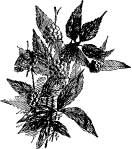
What a nasty taste they give the delicious fruit.
Even the flavor of the red raspberry is spoiled if one of these bugs pollutes it.[Pg 140]
What makes them smell so? May is asking.
The disgusting odor is caused by a liquid that is ejected out of little pores on the under side of the thorax.
The bug can eject this liquid when it pleases.

Most members of the bug order can eject a disagreeable liquid, though few of them do it so successfully as the stink bug.
If the stink bug is not disturbed, it does not give forth the bad odor; but when we jostle the bushes in getting the berries, that startles it, and we get the benefit of its alarm.
Yes, undoubtedly the bugs make a bad odor for the same reason the grasshoppers make molasses. They wish to repel their enemies.
Very few birds ever touch a stink bug.
Nell thinks a bird would be crazy to eat a stink bug.
Mollie says if it were not crazy when it began, it surely would be before it got through!
Not only the bugs make these disagreeable odors.
Many other insects do.
The cockroaches, as we know, and one reason we dislike them so is because of this offensive odor.
Some species of crickets, too, and indeed many, many insects give forth odors from glands that exist just for that purpose.[Pg 141]
No, indeed, these odors are not all alike. Some have a strangling quality like ammonia, and sometimes the odors are not disagreeable. Some insects have sweet odors, like perfumes.

The pleasant odors are not used to repel, but to attract.
If an insect wishes to see its mate, it may be able to give forth a pleasant odor that will reach a long way through the air, and the mate, smelling it, will follow it to its source. You see, this pleasant odor is one way of talking; at least it is one way of sending a message.
Insects can detect odors much better than we can.
No doubt many insects produce odors that affect other insects, but that are so faint we cannot smell them at all.
The sense of smell, even in the human being, is very wonderful. It is the keenest of all the senses.
You have studied weights and measures, and you know how small a quantity a grain of anything is. Well, you will be astonished to know that your nose can detect the presence of 1/2,760,000,000 of a grain of mercaptan, a substance having a very bad smell.

So you see, insects that can smell very, very much better than we would be greatly influenced by the odors of other insects.[Pg 142]
Some of the stink bugs, although so disagreeable if disturbed, are very useful to us, as they eat other insects injurious to vegetation.
Most of them, however, eat fruits and vegetables, and some species do a vast amount of mischief.
Yes, John, lice are bugs, and very mean bugs too.
They have lived at the expense of other creatures so long that they cannot exist unless they have a living body to feed on.
Here is a picture of one very much enlarged. No wings, no beauty, a pale white thing, all claws and mouth.

It has a long sucking tube by which it pierces the skin, and a sucking stomach by which it pumps the blood into its mouth.
Such creatures are called parasites.
Yes, bed bugs are parasites too.
Besides the lice that live on human beings, there are species that infest animals.
Bird lice are not lice!
That is, they do not belong to the bug order.
They belong to a small order by themselves, but they are parasites like the lice.[Pg 143]
The little white book lice that scurry away when we open an old book that has been standing on the back shelf, are not lice, either; they also belong to a little order of their own, and are constructed very differently from the true lice.
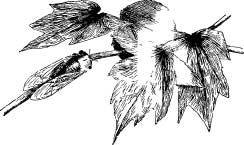
Whir-r-r-r-rrrrr!!
May says she wishes that locust would keep quiet. It makes her warmer than ever to hear him carrying on so this hot day.
John says it is the weather that is warm, not the song of the locust.
And yet, locusts generally sing during the hottest part of the summer, so that we have learned to associate them with warm weather.[Pg 144]
Since we must listen to its shrill out-cry, I wish we could also see it.
Ah, that is a wish soon gratified! Here comes one out of John's pocket.
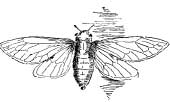
John says it is not a locust.
Ah, yes, the shorthorned grasshoppers are the real locusts, and this fellow has somehow got the name.
But it is not a locust.
It is also called the dog-day harvest fly, but it is not a fly, though it looks considerably like one.
Really, you know, it is a—bug!
Yes, it belongs to the bug order.
Its true name is cicada, and its shrill midsummer song has been famous from the beginning of time.

It looks like an enormous fly, but its mouth parts are the mouth parts of the bug, and in other respects it resembles the members of the bug order, when it is examined closely.
What glassy wings!
Let us spread them out carefully. Four of them it has.
The cicada, you see, has no wing covers. Nor are its[Pg 145] upper wings, half wing cover, and half wing, like those of so many of the bugs.
No, all four of its wings are alike, and all four are flying wings.
When it is at rest, the inner wings slip out of sight under the outer ones, which fold down like a roof over its body.
See how beautifully the wings, are veined.
You think cicada has a very broad back, Nell?
So it has, and a broad head.
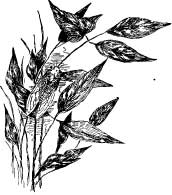
See its black eyes on the corners of its head!
How many facets have its eyes?
I wish I knew, but I do not. This, however, I can tell you. If you look on the top of its head between its compound eyes, with a magnifying glass, you will find it has three little eyes there.
These small eyes are simple, and are called ocelli.
Many insects have ocelli, indeed, some of the grasshoppers have these extra eyes on top of their head.
May says the grasshoppers are very astonishing insects.
You think you know all about them, and you are all[Pg 146] the time finding out something new. You would not be apt to notice these little ocelli on the grasshopper's head, they are so small, and besides, some of the grasshoppers do not have them.
Yes, Mollie, it is the same with the crickets and katydids. Some species have ocelli, and some have not.
If you look full in the face of a cicada,  you can see the three little
round ocelli between the compound eyes.
you can see the three little
round ocelli between the compound eyes.
They show very plainly with a magnifying glass.
Indeed, it is difficult to explain what the ocelli are for.
Some think they are to see objects close at hand, while the compound eyes see more distant objects.
Others think the ocelli are only capable of distinguishing light from darkness.

Yet others think they are merely a "survival" of the eyes of the worms. You know, way back in time, before there were winged insects there were worms. In some way the insects are descended from the worms, and though they have got rid of many of their wormlike parts they still retain some of them, and probably among these are the ocelli.
When an animal of any kind keeps organs that belonged to its ancestors, but that are of no use to it,[Pg 147] we say these organs are "survivals." They have not yet had time wholly to disappear.
Yes, John, the time may come when the ocelli will disappear from the insects. A good many insects have lost them already.
Indeed, you are right, May; they have lost them because they did not use them. When an animal ceases to use an organ in course of time, for lack of exercise, that organ dwindles away and disappears. It generally takes a very long time for this to happen.
Yes, Mabel, thousands or even millions of years may pass before an organ that has gone out of use entirely disappears. As generations succeed each other each generation loses a little power in that organ until, finally, there is no organ left.
John is puzzled to know just what is meant by an organ. It is some particular part of the creature. An arm is an organ, a stomach is an organ, an eye is an organ. The whole creature is made up of organs, and is called an organism.
Your whole body, John, is an organism, but your legs and arms are organs. Now, I think you understand.
Our cicada has one organ that is very interesting; it is the little apparatus by which it sings.
Turn it over, Ned, and all of you look at the two[Pg 148] thin plates lying against the abdomen just below the thorax.
Those membranes are like two little kettle drums, and they are its song organs.
There are other membranes beneath them, and large muscles within the body to move the membranes.
The membranes being set in rapid vibration we get the shrill cry of the locust.
Only the male has the kettle drums. In the female these organs are rudimentary, and she is dumb.

Cicada, you are a pretty little thing with your clear, glasslike wings and your black body with red and green trimming. See its mouth lying in that little groove under its head. It is a tube, and sharp. The cicada sticks it into a leaf or young twig to suck out the juice.
Nell wants to know if the young cicadas are like the old ones. Indeed, they would be cunning little things if they were, and—yes, they would look very much like flies.
But the young cicadas are queer babies, indeed. They do not look very much like their parents, although they have a head, a thorax, and an abdomen.

The female cicada makes a slit in the bark of the tree twig with[Pg 149] her ovipositor and lays the eggs there. As soon as they hatch out, the tiny cicadas drop down to the ground and burrow into the earth.
You would not know that they are cicadas, they are such queer-looking little things. But they have strong, sucking mouth parts with which they pierce holes in the roots of trees and suck out the juices.
Of course these larvæ grow and moult and continue to do so until they have moulted a good many times and grown quite large.
They stay down under the ground two years.
At the end of that time they crawl up to the surface of the earth in the early summer.
They climb trees, or weeds, or fence posts, and then the skin splits down the back for the last time, and out comes a full-grown cicada with bright glassy wings.
The wings of the larva do not grow at each moult like the wings of the grasshopper.
The larva never gets beyond short little wing pads. See John's eyes twinkling! I believe—yes, he has! He has brought us the cast-off skin of a cicada to look at.

Why, John, you are like a good fairy to us to-day, giving us just the things we want just when we want them.
Now, see this little shell. See the front legs, like[Pg 150] strong paws to dig with. And see its little glassy eyes, and its little wing pads!
It is a perfect cast of the cicada larva.

Yes, May, this little cast is made of chitin, and it will last a long time. Chitin is a very indestructible substance; even fire will not destroy it, but in course of time the moisture and the acids in the earth destroy it, so that at last the millions of cicada shells and grasshopper cast-off skins, which are also of chitin, and cricket moults, and all the other little cast-aside chitinous overcoats of the insects, return again to the earth and the air whence they came. The minerals and gases that compose them let go of each other, as it were, and the chitin is no longer chitin.
Amy says she has seen these little cicada shells hundreds of times but did not know what they were.
Yes, we are sure to find them almost every summer.
If we look, we will also find other larvæ shells. Down in the grass are the cast-off coats of the grasshoppers and the crickets.
All we need do is to look, and we shall be sure to find them—like unsubstantial ghosts of the active little wearers.
No doubt you all have heard of the seventeen-year locusts. They, too, are cicadas, and they look very much[Pg 151] like this one, only it takes the young ones seventeen years to complete their growth.
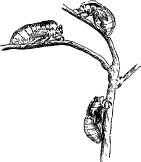
Think of living in the ground and sucking the juices out of the earth and of tree roots for seventeen years!
How would you like to do it?
But no doubt the cicada is quite happy living in this way.
At the end of seventeen years the cicadas come up out of the earth in great swarms.
They cast their skins for the last time. The queer little shells are seen everywhere, and the air resounds with the songs of the freed prisoners.
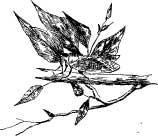
In the South it takes only thirteen years for these cicadas to develop.
I once went up the side of a beautiful mountain in North Carolina, where was such a mighty host of cicadas in the trees that I could not hear my companion speak, and a little way off the noise sounded like a torrent of rushing water.[Pg 152]
Why, little Nell! What is the matter?
You do wish the frogs would stop spitting on the grass?
Let me see; why, poor child, she is all covered with frog spittle.
That is kind, Ned. See, he is wiping her apron off with some fresh, clean leaves. Let us rest awhile under this shady tree.
John, pick that grass blade with the frog spittle on it. Be careful not to disturb it.

There is a surprise in store for you; this white frothy substance that is so abundant in some places in the summer and that looks like spittle is—guess what?
Frog spittle, May says. So you think the frogs spit on the grass do you? They must be tall frogs to reach up so high.
With this little twig let us carefully brush away the white froth.
Now see.
Yes, there is something in the centre of it.
It is the larva of a—bug!

The female bug, and here is one of the little things, lays the egg on the leaf or twigs, and when it hatches the[Pg 153] young bug sucks out the sap of the plant which finally appears as this white froth.
The larva remains surrounded by the froth until its transformations are complete.
Just before the last moult it stops sucking out sap. The froth dries about it in the form of a little room, and in this it undergoes its last moult and comes out—an adult bug.
The froth is supposed to be used as a protection, and it may be against some enemies, but there are certain wasps that delight in invading the frothy masses and hauling out the unwilling morsels within to feed to their young.
No, little Nell, the frogs have nothing whatever to do with this frothy substance which was called frog spittle before people understood about the little insect that made it.
They really thought the frogs did it.
The adult spittle insect is called a frog hopper, and it has the power of leaping very well.

Just see this bush! Be careful not to shake it.
It is covered with such pretty, bright-colored little insects.
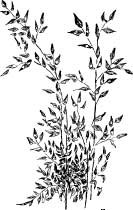
There, May ran against the bush and see—they are hopping wildly off in every direction.
Yes, little Nell, they do sound like rain drops pattering on the leaves.
They are prettier than the spittle insects and more slender, but they hop about in very much the same way.
The larvæ do not make froth, however.
These are the leaf hoppers.
What big heads they have!
And how daintily their green forms are pencilled with red lines.
There are a great many species of the leaf hoppers, and not all of them are as pretty as these.
Some of them are very small indeed, and some do great damage to the grain crops and the fruits.
They suck out the juices of the plants.

If you sweep the insect net over bushes or through[Pg 155] the grass in midsummer, you will be pretty sure to draw in a good collection of leaf hoppers.
Most of us are only too well acquainted with the rose-leaf hopper that swarms on rose bushes and kills the leaves. If we have not noticed the insect itself, we have not failed to notice the little white skins that it has cast off and left clinging to the leaves.
Yes, these are the little skins it discards when it moults.
John says we can kill them by washing the bushes with strong soap suds.
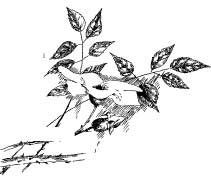
Ned says it is better yet to spray them.
It is better and also easier to spray them than to wash them.
You know there are machines for spraying trees and other plants. They consist of a tank to hold the liquid that is to be sprayed and a pump to force it through a rubber pipe with a sprinkler at the end.
Very often a mixture of soap and kerosene oil, known as "kerosene emulsion," is used to spray with.
Paris green and blue vitriol, both very poisonous, are often used on grape vines before the grapes are formed,[Pg 156] and very gaudy vines they are for a little while after this bright poison has been sprayed upon them.
Although insects are so very interesting, we have to protect ourselves against many species in order to live.
Yes, John, it is oftentimes merely a question which shall profit by the crops we plant, the insects or ourselves.
Sometimes the insects win, sometimes we win, but it is a closely contested warfare all the time.
We plough the land and take care of it, we plant the seeds and keep out the weeds. Then, when we have a fine crop growing, along come certain destructive insects, feeling very happy, no doubt, to have found such a feast.
Now the fight begins. They attack the crop, we attack them. We spray them with poisons, burn up their eggs, do everything we know how to get rid of them.
Wise men have spent many years of close study finding out the habits of the insects destructive to grains and fruits, in order to be able to destroy them.
Although many of the plant hoppers are such nuisances to us, there is one family of hoppers that is seldom a nuisance.[Pg 157]
Do you know the tree hoppers,—absurd little jokers that they are?
Oh, yes, they are hard and three cornered, like animated beechnuts, as somebody has said.
Yes, some of them have humps on their backs and some have horns.
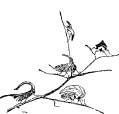
John says he once made a collection of tree hoppers and put them in a box with a reading glass over the top, and showed them to his friends to make them laugh.
May says she saw them, and they reminded her of Brownies.
Would it not be fun to have a tree hopper Brownie book!
The tree hoppers jump about on the bushes and eat the juices of the plants, but there are not usually enough of them to do damage. They seldom come in swarms like some of the leaf hoppers, though sometimes they do.
The jumping plant lice are nearly related to the tree hoppers, but they do not look at all like them.
Under the magnifying glass they look like tiny cicadas.[Pg 158]
See, here is a picture of one enlarged.

Their natural size is no larger than a plant louse.
Have you not often seen them clustered close together on the young twigs of pear trees—tiny, light-colored things that jumped in all directions when you touched the twig?
The name of the plant louse that infests pear trees is the pear-tree psylla. It is very destructive to pear trees, sucking out the juices of the young shoots.
The pear trees can be saved by spraying them with kerosene emulsion as soon as the young leaves have opened in the spring.
Now, let us go in search of the aphids, or aphides, as they are also called. We shall not have to search far.

In a very dry season we generally need not search at all. All we need do is to examine the nearest weed to find plenty of aphides.
Yes, they are the little plant lice that seem at times to cover every growing thing.
Sometimes they are green, sometimes brown, or gray, or reddish, in color.[Pg 159]
They are tiny creatures, but what they lack in size they more than make up in numbers.
Go now, and find some aphides.
Ah, here you all come, each bearing a leaf or a twig on which are aphids.
There was no trouble in finding them!
They do not hop like the jumping plant lice when they are disturbed. They remain where they are unless they are very much shaken up.
See, most of them are without wings, though here are a few with beautiful transparent wings.
Antennæ they have, long and threadlike. And see, the knowing little eyes!
They seem to be anchored to the leaf.
Hold the leaf up to the light, and see if you can discover what they are doing.
Ah, see those mouth tubes firmly stuck into the leaf. There they stand all day long and suck out the juice.

Ned says he should think they would burst.
But they do not; they grow. And they also get rid of a large part of the superfluous sap in a curious way.
They use what they need to grow on, and the rest escapes from the insect's body in the form of "honey dew." It is a sweet liquid of which ants and bees are very fond.[Pg 160]
What, John, you have heard that the aphids give out honey dew from two little horns near the tip of the abdomen?
Let us see if we can find these horns. Yes, we can see them plainly, and very plainly with a magnifying glass.
But now listen; the honey dew does not come from the horns. On the end of some of the horns, or tubes, we can see a drop of clear liquid.
For a long time people believed this was honey dew, but instead, it is a waxy substance which is not sweet.
It has been very carefully studied by wise men who tell us it contains no sugar and is probably used as a means of defence, as aphides have been seen to smear the faces of insect enemies with this wax.
There are a great many species of aphides, and not all of them have the little tubes or horns on their backs. But probably many that have no horns give forth honey dew.
It is really a waste substance from the body of the aphid.
Ants are so fond of the honey dew that certain species of aphides have been called the ants' cows, because the ants take care of them for the sake of the honey dew.
Some ants protect the aphids from their enemies.[Pg 161] They drive off those insects that would devour the aphids, and when winter comes these ants carry the aphids down into their warm nests under ground, and keep them safe through the cold weather.
The aphides cannot stand wet weather, but after a long spell of dry weather they will be found in great abundance.
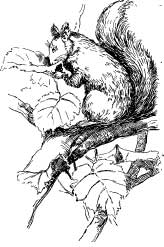
Sometimes they eat so fast and so much that the honey dew falls like a shower from the trees upon which they are. It covers the ground beneath and the leaves of plants, and makes everything very sticky and disagreeable to the touch. The dust settles on it, too and a growth something like mould often turns it black—as we find to our discomfort.
But when the honey dew is fresh the bees love it. They collect large quantities of it and make it into honey. Squirrels like it to.
It is great fun to watch the nimble squirrel folk sitting in the trees and holding a leaf between their little hands while they lick off the honey dew.[Pg 162]
Children sometimes suck the honey dew from the leaves in back country places, where sugar is scarce and where candy is seldom to be had.
Which side of the leaf does the aphid prefer?
Yes, it is on the under side always.
I wonder why.
John says the aphides would be better protected in case of a shower.
Ned says the skin is tenderer on the under side and easier to pierce.
Mollie thinks they want to be in the shade out of the hot sunshine.
I should not wonder if all of these reasons were right.
My little aphid, how many wings have you when you have any?
Yes, little Nell, they have four of the daintiest, prettiest little wings you ever saw.

True enough, most of them have no wings at all.

John thinks those must be young ones.
Sometimes they are, but not always. Many of the adult aphids have no wings.
The aphids are very curious insects, and when you are older I hope you will remember to study them carefully.[Pg 163]
No, John, not all species of aphides make honey dew.
Some form instead a white, powdery substance that is seen scattered over the body.
May says that must be the kind she has.
Let us see. Yes, May's aphids produce the white powder instead of honey dew.
That is their way of getting rid of the waste matter.
May says she is glad to know that; she thought her aphids had something the matter with them. They seemed to be falling to pieces.
No, May, they are not falling to pieces; that powder can all be rubbed off, and there are your aphids whole and sound beneath it.
Do you know that some species of your funny little tree hoppers secrete honey dew also, and even have ants to attend them? See if you can find some of these this summer.
Sometimes aphids live on the roots of plants as well as on the leaves.
Yes, indeed, May, they are very destructive insects. We have to spray our house plants to get rid of them, and often our garden flowers as well, and they do a great deal of damage to fruits and vegetables, and one of them, the phylloxera, has nearly destroyed the vineyards of France. It lives on the leaves of some species of grapes and on the roots of others. We have to be very careful[Pg 164] about getting grape vines from Europe to plant in this country on account of the phylloxera.
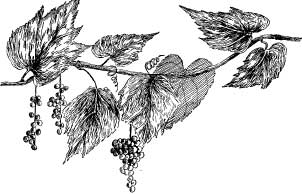
What have you found now, John? Ah, yes, an alder branch, with a white, cottony substance on it. You have been poking into it with a little stick, and you think there are insects beneath it.
What, May, you always thought that white stuff was a plant growth, like mould?
We can easily find out. Get out some of the little things inside if you can, John. It is not easy to separate them from their cottony covering without crushing them, but now we can see quite well with the magnifying glass—and yes—you see they are little insects.
We call them the woolly aphids.
They also secrete honey dew.[Pg 165]
You say the ground below the alder bush was all sticky and black, John?
That was the honey dew, blackened by a little plant something like mould, that grows on it.
We often see woolly plant lice in the summer-time on different plants, and one species injures apple trees. It gets on the roots as well as on the tender bark of young trees and kills them.
Yes, indeed, Mollie, the aphids are bugs. They belong to the bug order, which is a very large and important insect family, and contains some members that are exceedingly troublesome to us.
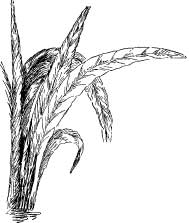
What, May, you are tired out?
What have you been doing?
Oh, yes, washing the scales off the leaves of your mother's window fern.
It must indeed have been a task; what did you wash them off with? Why did you use soap suds?

Because your mother told you to; well, that is a good reason, but why do you think she told you to use soap suds?[Pg 166]
You say you don't know, but you think very likely these scales are some sort of bug, as everything nowadays seems to be bugs.
Well, I don't know about everything being bugs, but those scales certainly are. They are scale bugs.
Did you stop to look at them under the magnifying glass?

No, but you brought a piece of the fern for us to look at.
It will be necessary to put it under the microscope.
There, now look.
Yes, that scale looks like a tiny mussel shell; but look carefully, and you will see it has legs.
Lift it up with the point of a pin, and under it you will find a mass of eggs. Yes, Ned; it is like a quantity of eggs under a dish cover.
The cover is the female scale bug, and she has laid all those eggs.
Yes, the scales we see on so many plants are the scale bugs.
They are not all alike in shape, or size, or color; here is a different kind, you see.
But they are all very prolific; that is to say, they produce a great many young, and do it in a short time.[Pg 167]
Yes, John, the tiny, dark-colored scales that look like little oyster shells on the skins of oranges are a form of scale bug, and a very troublesome one, too, to the orange grower.
But though most of these insects are troublesome, the family is redeemed by a few members that are of great value to us.
One of these is the scale bug that supplies shellac, and all that comes from it to our markets. These curious bugs give forth a resinous substance that envelops the eggs and glues them to the twigs whose juices the bug sucks out. It is this resinous substance that is collected by breaking off the twigs where the insects are. It is used for varnishes, as you know, and for polishing wood and other substances.
There are other scale bugs that secrete wax, and some of them produce it so abundantly, and of such good quality, that it has become an article of commerce. China wax, which is wax of a very fine quality, is secreted by a Chinese scale bug, and the wax is used for making fine candles, as well as for other purposes.
In Mexico we have the cochineal insect, which is a scale bug that lives on a cactus that grows in Mexico.
Like many others of the scale bugs, the cochineal males have wings and are not so scalelike as their helpless mates.[Pg 168]
But they are of no use to us. It is only the female cochineal we use.
She is raised in great numbers in cactus gardens planted on purpose.
Here is the picture of a cactus with cochineal insects upon it.

These insects contain a very brilliant, red coloring matter that is used by us in dyeing leather and wool, and in making paints. The insects are gathered and dried, and thus sent to market.
Although a few of them are useful to us, the scale bugs, on the whole, are a serious pest; and they are found on nearly all kinds of plants all over the world.
You should think all the plants would soon be gone, so many insects eat them?
Well, they would, only other things eat the insects.
Insects have a great many enemies, after all.
Sometimes the weather is bad for them, the season is too hot or too cold, too wet or too dry, and then they do not appear in large numbers.
Sometimes one kind of insect eats another kind.
Sometimes tiny plants, like moulds, grow on the insects and kill them; and birds destroy a very large number.[Pg 169]
If the farmers only knew how much good the birds do them, they would never allow one to be killed. Even the crows that pull up their corn are worth many times the corn they eat in the insects they destroy. There is scarcely a bird but what is of value to the farmer.
The hawks that catch his chickens catch more mice and moles in his fields, than chickens in his barn-yard.
And as for the robins, the blue jays, and all the small birds, they do more to save the growing plants, than all the soap suds and kerosene emulsion that were ever made.
No one should ever shoot a bird. The birds are our natural protectors against the vast armies of insects, that, but for the birds, would soon destroy us by eating up our food plants.
What is that, May? You belong to an Audubon Society for the protection of the birds?
Yes, I know you do, and so do John and Ned and Mollie and little Nell.
I wish every child in the United States belonged to the Audubon Society. Then our birds would be safe. They would never be killed as they are now for foolish women to wear on their hats.
When the Audubon Society children grew up they would not wear dead birds, of course, and their children[Pg 170] would be taught better, so that after a while the Audubon Society people would be the only ones left, and so the birds would be safe.
Let us get as many people to belong to the Audubon Society as we can.
What is that, Amy? You have learned more interesting things about birds in the Audubon Society than you ever knew in your life before?
Yes, I am sure you have, and what could be lovelier to study about than the birds.
What is that you are saying, Ned? You love to go bird hunting? Ah, I see your eyes twinkle, sir; I know how you go hunting. You hunt with your mother's opera glass! That is the proper way to hunt birds.
We can learn more from watching one bird with a glass than we could from shooting a hundred.
But you do shoot them, John? Yes, I know about that, too. I know what kind of a shooting instrument you got for Christmas, sir, and I have seen the birds you shot!
Yes, nearly all of us have seen them, and how well he does it!
What, Amy, you think John ought to be ashamed of himself to go about shooting birds, and we ought to be ashamed of ourselves to talk so about it?
There, now, don't be vexed with Amy, children. She[Pg 171] has known us but a little while, and she has not seen John's birds, so I do not wonder she feels indignant.
What is that, May? You have one of John's birds right here in your school-bag? Show it to Amy.
Isn't it pretty! It is a very charming photograph of a catbird on its nest.
You see John shoots birds with a camera! His father gave him a beautiful one for Christmas, and he has made good use of it.
How long did it take you to get that bird, John?
Just hear! He spent more than a week getting acquainted with the bird so it would sit still on the nest while he took its picture.
I am sure that was a week well spent.
John says he feels better acquainted with the catbird than he would have been if he had read fifty books about it.
And I am sure he is right. The only way to enjoy a bird and to know it, is to watch it alive.
A camera is the very best gun in the world for catching birds. And it is really much better fun to take their pictures than to shoot and kill them.
It seems to me we have strayed a long way from bugs.
May says she thinks birds are much more interesting than bugs.[Pg 172]
That may be, but still we want to know about bugs, too.
Do you think you will know a bug when you see it now?
No, I do not believe you can be sure of that. But at least you know something about a few bugs.
Some day you will study more carefully how insects are formed, and then you will understand better how we decide what order they belong to.
We group together the insects that are most like each other.
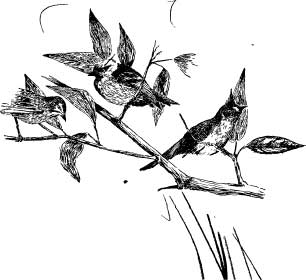

No more bugs, if you please.
We are to make the acquaintance of another order of insect folk this time.
I think we can find some worthy members of this new order if we go with John to a brook he knows of.
Here we are, and it certainly is a lovely brook, whether we find a dobson in it or not.
Yes, Nell, the dobson is the new insect we shall try to find.
Now, be careful and not get your clothes too wet, but we have to turn over the stones along the edge of the brook until we find what we are after.
Mollie wants to know how she is to know it if she finds it.
Well, Mollie, whatever you find that is interesting you must show us. Even though it is not what we are searching for, we shall enjoy seeing it.
Look at little Nell! She has tumbled into the brook. Her foot slipped, and down she went.[Pg 176]
Don't cry, deary, you are not wet enough to do any harm. The warm sun will soon dry you.
No, indeed, you will not have to go home.

Perhaps you will be the first one to find a dobson after all.
Hurrah! hurrah! hear John shout!
He must have found the first dobson.
Yes, he has.
What, May? It is a horrid monster, and you have a good mind to scream?
Well, scream if you want to; that won't do any harm.
It isn't pretty! but we shall like to look at it. You see it is a larva and a big one, dark gray in color and with a thick leathery skin.
Mollie says it reminds her a little of the larva of the May fly; that is, in shape.
Let us look at a picture of the May-fly larva.
You see it has a head, a thorax to which is attached the six legs and the rudimentary wings, and an abdomen, all distinctly separated from each other.

The dobson has a head, but no thorax.
The body behind the head is divided into segments that all look very much alike, and there is a pair of legs attached to each of the first three segments.[Pg 177]
The dobson eats other larvæ that it chews up with its strong jaws.
It lives almost three years in the larval state, so you see it has plenty of time in which to grow. Of course it moults. It is usually to be found under stones in swift, running water. Those two pairs of hooks at the tip of its body are its anchors.
It clasps them about a bit of stone or a stick that is firmly lodged, and then it can bid defiance to the swirling stream.
Ned wonders why it is always found hiding under stones.
Listen to John, he says fishes are very fond of dobsons, and that is why they hide away.
Fishermen hunt the dobsons for bait; so you see they have a hard time in spite of their large size and their strong jaws.
When they have lived nearly three years in the water they crawl out on the bank and hollow out a place under a stone.
Here they lie, apparently dead, but they are not dead.
They are undergoing a wonderful transformation.
It takes about a month for this transformation, or metamorphosis, as it is called, to be completed.
All of our other insect friends have changed grad[Pg 178]ually from larval to adult form. At each moult they became a little more like their parents, and finally at the last moult, without any resting period, out sprang the perfect insect.
Not so the dobson. It goes into its hole in the bank a larva, almost exactly like the larva that hatched from the egg, only, of course, it is larger. There is no hint of wings. It has no separate thorax and abdomen. Could we see under the bank where it has crept, to undergo its great metamorphosis, we should find, not a larva, but a strange-looking, motionless object.

Here is the picture of one. See its little wing pads. And now it has a thorax and an abdomen.
It seems to have changed and been turned to some hard substance.
In this state it is called the pupa, which means doll. Is it not a cunning insect doll? But it is not really a doll. Although so still and apparently lifeless, yet it lives.
Some day it will burst its pupa shell and pull itself out—not a larva now, not a pupa, but a strong-winged insect.
In its adult form, it is known as the horned corydalus.
There! I thought John was saving one for us. He[Pg 179] had it in a box in his pocket. Now see what a—a—what shall I say? A beauty? or a monster? That is just as you feel about it.
It certainly is an alarming-looking insect.
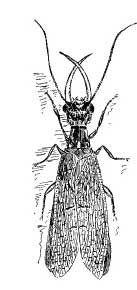
This one is a male, as we can tell by the long, curved jaws that look very dangerous; but in this instance the creature's appearance is worse than its bite, and the real biter is the female whose jaws are smaller but very useful in nipping tormentors or biting prey.
Now here she is—a fit mate for her formidable-looking companion.
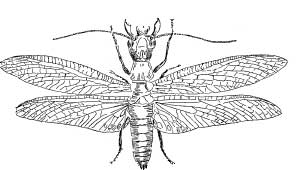
John, you were fortunate in your hunting.
In spite of its terrifying appearance, see what wonderful wings the corydalus has.
See! John has spread out the wings of the female.
They are indeed beautiful.
May cannot understand how those great wings came out of those little wing pads.
When the wings were first pulled out of the wing pads they were small, but they rapidly expanded and became thin and broad and long as the air touched them.
You will understand that better after a while.
The corydalus differs from all the other insects we have studied, in its metamorphosis.
It begins life far more unlike its parents than the other insects we have been looking at, for they had the thorax and abdomen distinct from the beginning. Instead of changing gradually and remaining active all the time up to the final metamorphosis, our corydalus goes into the pupa state, and in that motionless condition transforms to the perfect insect.
This is called a complete metamorphosis.
When the change is gradual, without any pupa form, any stopping place as it were, the change is said to be an incomplete metamorphosis.
Yes, the metamorphosis of the grasshoppers is incomplete, and of the katydids and the crickets and all[Pg 181] the other insects we have studied until we came to the dobson.
Another name for the larva of insects that undergo an incomplete metamorphosis is nymph. Some books speak of the nymph of the grasshopper, and never of the larva of the grasshopper. Such books use the word larva only in speaking of the young of insects that undergo a complete metamorphosis.
Yes, Ned, they would speak of the nymph of the dragon fly, and the nymph of the May fly and the nymph of the cricket and the katydid, but they would speak of the larva of the corydalus.
Egg, nymph, adult,—those are the stages of insects that have an incomplete metamorphosis.
Egg, larva, pupa, adult,—those are the stages of insects that have a complete metamorphosis.
No, it is not wrong to say larva instead of nymph. I only want you to know how the word nymph is used, so that when you see it in reading about insects you will know what it means.
The corydalus lays its eggs near the water, and it lays a great many—sometimes nearly three thousand. Think of that! The young larvæ crawl into the water as soon as they are hatched, and those that escape the hungry fishes grow into these large larvæ and finally metamorphose into the big-horned corydalus.[Pg 182]
It is such a remarkably fierce-looking creature that it has received many names that are neither complimentary nor beautiful, such as conniption bug, alligator, and dragon, and numerous others equally expressive.
Now, we must go home. Let us put the dobson back into the brook.
It does no harm, and we will not kill it.
Yes, Ned, there are smaller insects like the corydalus that are near relatives to it, and I am sure you have often seen them.[Pg 183]
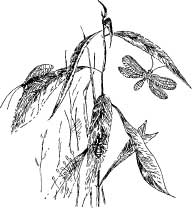
Here is our little Lacewing.
May says it is a darling, like a woodland fairy clad all in green.
And, oh, its eyes! Are they not beautiful? They shine like gold.
Do its wings not remind you a little of the wings of the corydalus?
May says no, indeed; that has ugly brown wings.
But look again, May. See how these wings are veined, and do you not remember how you admired the silvery wings of the corydalus when we spread them out?
Yes, it belongs to the same order as the corydalus.
The name of the insect order to which they both belong is Neuroptera, from neuron, a nerve, and pteron—who remembers what pteron means?
Yes, a wing. Nerve-winged.[Pg 184]
What does that mean?
It means that the wings are crossed by many nerves or veins. Yes, that is what gives them their lacelike appearance.
Pretty golden eye, why do we not oftener see you on the trees and bushes? It is only by accident we found you to-day, down in the grass.
The truth is, this pretty fairy hides by day and comes out at night to lay its eggs. Like the May fly, the adult lacewing does not eat. It is a helpless little beauty, though it has one powerful means of defence, as you will discover if you touch it.
Ah, yes; you have already detected it! It gives forth such an offensive odor that nothing, one should think, could have the hardihood to eat it.
May says she supposes the larva of the lacewing is a little monster like that of the corydalus.
But you will not expect to find it as large as a dobson.
I think if we hunt about a little, we can find one.
Here is one on the leaf. See what a little fellow! And how fast it runs!

We shall have to take it captive, in order to get a chance to see it.
It is a funny little larva, with jaws that are tre-men-dous for one of its size.[Pg 185]
Why do you suppose it has such jaws?
May says, for the usual reason, to eat up other larvæ.
Yes; but wait till I tell you another name for this larva.
It is also called the aphis lion.
Aphis, you know, is the same as aphid, or plant louse. In other words it is the plant-louse lion.
Ah, yes; you are quite willing it should devour the aphids.
And it does. It is very fond of them, though it will also devour any unlucky insect it is strong enough to overcome.
It has a terrible appetite, this child of the pretty lacewing.
It would even eat its brothers and sisters before they hatched out of the egg if it could get at them.
The pretty lacewing knows what an appetite her ever hungry larvæ will have, and so she protects them against each other.
Clever little mother! she lays the eggs in such a way that the larvæ that hatch out first cannot devour the rest of the eggs.
How do you think she manages it?
Here are some of her eggs on this leaf.
Yes, John; each one is on top of a slender stalk.
The stalk is of stiff silk.[Pg 186]
There they are, like a little forest, with an egg for each tree top.
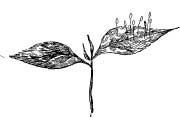
When an egg hatches the young aphis lion drops down to the leaf and runs about like a ravening lion seeking some living thing to devour.
Above his head, quite unsuspected by him, are the eggs out of which his brothers and sisters have not yet hatched.
What a feast he could have if he knew about it!
And what a sad little cannibal he would be!
The larva of the aphis lion has no distinct thorax. Its legs are attached to the upper segments of the body, and its metamorphosis is like that of the corydalus.
When about to become a pupa, it makes for itself a little covering of white silk. Here it lies quite motionless and undergoes the final transformation.
Yes, its metamorphosis is complete.
It bites an opening through its silken walls, and out steps—not the hungry, little, all-devouring aphis lion, but this elegant lady with her pale-green lacelike wings and her large, golden eyes.
You see the aphis lion is our very good friend.
It helps us get rid of the aphids, and we should never kill a lacewing or a child of the lacewing.[Pg 187]
John has found something he wants us all to see.
We will go with him.
Now we will sit down on this sand bank and look at what he has to show us. See! those smooth little funnels in the sand.
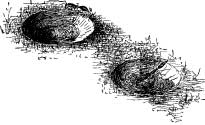
Those are what we have come out to see.
Let us watch them a while.
Mollie says an ant is walking close to the rim of the funnel she is watching. Now the ant slips over the edge and slides down the smooth sides of the funnel.
And see! from the bottom of the funnel leap out two curved jaws and—good-by, ant!
The ant has been dragged down out of sight through a hole in the bottom of the funnel.
What a strange proceeding!
Who can be living down there at the bottom of the funnel?
We are sorry to disturb such a pretty piece of work,[Pg 188] but we shall have to dig out one of the funnels. We shall have to be quick, too.
There, there, under the trowel! No, it is gone. There it is again. Dig fast, Ned. That is right. He has put it with a trowelful of sand into our box.
We will gently shake out the sand until we uncover it.
Mabel says it is just what she thought it was—a larva.
Yes, it is a larva.

You see it looks a little like the lacewing larva, and it, too, belongs to the Neuroptera.
What jaws!
How do you suppose it makes its tunnel?
If we give it plenty of sand, and keep very quiet, perhaps it will go to work.
There! it is throwing the sand about.
May says it is using its own head as a trowel. Yes, it is shovelling the sand away with its head.
Why is Ned laughing? Oh, see the ant lion he is watching! An ant slid part way down its funnel and tried to climb out again, and the ant lion down below is flinging sand at it.
There! it has succeeded in making the poor ant slip; down it goes, and now the ant lion has seized it and dragged it down under the ground.
It is easy to find these pit-falls of the ant lion in sand banks in the summer-time.[Pg 189]
Yes, May, the ant lions eat many ants, and they moult and grow, and, finally, they, too, make a little cocoon about themselves.
Yes, the little silken room they weave we call a cocoon, but the ant lions make theirs of silk and sand.

Within the cocoon they become motionless pupæ, and finally appear as silver-winged little creatures that bear no resemblance to the large-jawed, ever hungry, ant lion.
May says she thinks the Neuroptera differ from all the other orders in the way the larvæ transform.
That is true, May, they do.
In no other order that we have studied do the insects go into the pupal state to undergo the final transformation.
Who remembers what the young of insects that undergo an incomplete metamorphosis are sometimes called?
Dear me, you all remember!
Yes, the young are sometimes called nymphs.
The nymphs do not change into pupæ.
The young grasshoppers do not change into motionless pupæ, they just keep on growing until they are perfect adults.
Young grasshoppers are sometimes called nymphs instead of larvæ.[Pg 190]
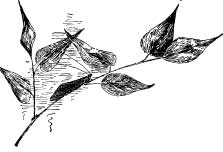
Here we are in the woods again.
How sweet it smells!
Let us sit down by this brook and look into it.
It is such a clear little stream, with fine sand and little pebbles at the bottom.
What has Nell found that pleases her so?
She says she sees some little bars of sand moving about.
Ned says they are not sand bars but tubes of sand, containing a little live thing.
The truth is, this sand bag is a house, and its occupant is a larva.

See the black head come popping out, and the tiny fore legs.
The larva does not come entirely out, you see, but pulls its house along with it, and when it is frightened it pops back into its little stone case.
Mollie says it reminds her of a hermit crab.[Pg 191]
A hermit crab, you know, lives on the seashore and takes possession of an empty snail shell for a house.
It comes partly out dragging its house with it, but if you disturb it, it draws back, sometimes quite out of sight.

This little larva lives in a house, too, but it is a house of its own making.
It is the larva of the caddice fly, or case fly.
Let us put one of these little sand cases in the saucer here.
Please fill the saucer about half full of water, John. Thank you.
Now, Mollie, I see you have picked up a fine big caddice case.
Put it in the saucer, and let us watch the larva crawl about.

It never comes entirely out of the case, you see. It holds on to it with the hinder part of its body.
Its little black head is hard, but its body is soft, and that is why it does not like to expose itself to hungry larvæ that might be living in the water.
May says she wants to see the whole larva.
Suppose we carefully break away the little sand case.
No, indeed, little Nell, we are not going to hurt the larva; we are only going to open its house.

There, the larva is outside now, and you can see what a tender, pale little thing it is.
It does not like to have its soft body exposed.
See! it is already gathering little bits of sand together.
It seems to be sticking them fast to its body.
It is really binding them together by a saliva-like substance from its mouth.
It draws out little glistening threads that harden into silk as soon as they touch the water.
Queer saliva you think.
But the caddice larva does not find it queer. It is used to saliva that hardens into silk.
Yes, that is the way the larva of the aphis lion and of the ant lion made their cocoons. They spun out silk in this manner.
The caddice larva makes its house of silk and sand and also lines it with a beautiful covering of fine silk.
Yes, May, it papers its walls with silk.
You see it did not hurt the caddice larva to take away its house; it immediately went to work to build another.
Why not pull it out, instead of breaking its house to pieces?
Because if it had been pulled hard enough to come out, it might have been torn to pieces, it is such a tender little thing, and it holds fast so tightly.[Pg 193]
So the best way to remove it safely is to break its case bit by bit from around it.
It does no harm to break its case if one is careful. It will soon build another.
Yes, this larva has no distinct thorax. It is like the larvæ of the dobson, the aphis lion, and the ant lion in that respect.

See! John has found one whose tube is made of quite large stones as compared with this tube of fine sand that we have broken open.
Some caddice larvæ build houses of wood instead of stone. They stick little twigs together, and some use little pieces of leaves.
Others again use tiny snail shells which, as you can imagine, make very pretty cases.

Our little caddice has made a neat little house of fine sand grains very nicely put together.
Some others make much rougher houses.
You will be apt to find the caddice larvæ in any brook and in some ponds, and I hope you will always look for them.
Notice the tracery in the soft mud of the brook.
Those lines that look as though some one had been ornamenting the bottom of the brook are made by our caddice larvæ.[Pg 194]

They drag their cases along and thus make these lines.
Sometimes such lines are made by the little fresh-water snails; but you can always find the decorator by following along the lines he makes.
What, May? How is the delicate larva able to cling to the case tightly enough to pull it along? If you look at it very carefully, you will find a pair of tiny hooks at the tail end by which it can hold on to the silk lining; and some caddice larvæ have hard points on their backs which help them to hold fast.
The caddice larvæ are carnivorous; that is, they eat animal food.
Yes, May, their food is usually the larvæ of other insects, but you will be glad to know that some of them eat plants too.
They eat the larvæ of the May flies when they can find them and no doubt they build these strong cases about themselves to prevent the May fly larvæ from returning the compliment.
Frank has found some empty cases, yes, and some that are closed at both ends.
Now, let us look at this one closed at both ends. What do you suppose is in it?[Pg 195]

We will open just one of these closed cases.
There! It is a pupa! Yes, Nell, a very pretty doll is this.
It has a thorax, you see, and an abdomen. Its long antennæ lie close to its body as do its little wing pads.
Yes, the caddice larva grows and moults in the usual way. It keeps adding to its house as it grows longer. Finally, it closes the end of its little tube and lies quite still.
You know what happens next. Its wormlike form divides into thorax and abdomen. Legs and wings appear, attached to the thorax. In short, it is no longer a wormlike creature.
Finally, it comes forth from its case. It never goes into it again.

It does not need to, for now it is a dainty little nun, with a long, tan-colored cloak. Its cloak, of course, is its wings folded down about its body. Like the fairy May flies it has no mouth and eats nothing in the adult form.
It looks like a dainty brown moth as it flutters about the bushes and goes flying up and down the brook.
You will always find these little brown-cloaked figures flitting about the brooks, where the caddice larvæ live.
You see the caddice undergoes a complete metamorphosis.[Pg 196]
No, it does not belong to the Neuroptera.
Examine its wings very carefully. Look at them through the magnifying glass, and you will see they are clothed with hairs.
So these are the hair wings.
The name of the order to which they belong is Trichoptera, from pteron, a wing, and thrix, a hair.
Sometime you must take a caddice larva from its house and put it in a saucer of water with fine bits of mica, which you know is another name for the isinglass that makes the little windows in our stoves.
If you are fortunate, your caddice will build for itself a little glass house, through whose walls you can look and see what is going on inside.
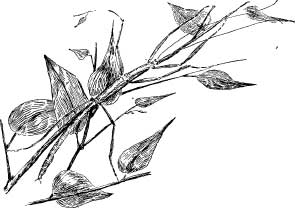
Abdomen (ab-dō'-men). The lower part of an animal's body. The part behind the thorax in insects.
Adult (ă-dult'). (L. adultus = grown up.) Grown to full size and strength.
Anchor (ang'-kor). (Gr. = a hook.) Anchors are used to fasten ships by a line to the bottom of the sea. Applied to anything that holds a movable body fast in one place.
Antenna; pl. Antennae (an-ten'-nee). The feeler in front of the insect's head with which it hears and smells as well as feels.
Aphis (ā'-fis) pl. Aphides (af'-i-dēz).
Aphid (af'-id) The plant louse, of which there are a great many kinds.
Apparatus (ap-a-rā'-tus). Tools or machinery used in working or in making things.
Aquarium (a-kwā'-ri-um). (L. aquarium = watering-place for cattle.) A vessel of water for keeping water plants or water animals.
Attract (at-trakt'). (L. attractus = draw to.) To draw toward.
Audubon (aw'-do-bon), John James. A very famous student of birds and their ways. In his great book, "The Birds of America," which was published in 1827, there are many large colored drawings made by himself.
Beech-nuts Small, three-cornered nuts that grow on beech trees, and that are very sweet and good.
Breeding-place The place where young animals are born.
Brood A family of young animals.
Caddice, or Caddis fly (kad'-is flī). Sometimes called "case fly," from the case or shell which the larva makes about itself; "caddice" is another way of saying "case."
Camera (kam'-e-ra). An instrument for taking photographs.
Cannibal (kan'-ĭ-bal). A human being who eats human flesh. Any animal that eats others of its own kind.
Cargo (kar'-go). The goods or merchandise or whatever is carried in a ship.
Carnivorous (kar-niv'-ō-rus). (L. carnivorus = flesh-eating.) Applied to animals that feed on flesh, and plants that feed on insects.
Cast The cast-off skin of an insect that keeps the form of the insect's body.[Pg 200]
Characteristic (kar-ak-te-ris'-tik). Showing the peculiar qualities of a person or thing.
Chitinous(kī'-tin-us). Hard, horny, and shell-like.
Cicada (si-kā'-dä). (L. cicada = tree cricket.) A popular name for insects, like the grasshopper, locust, and cricket, which make a creaking or chirping noise.
Cochineal (koch'-i-nēl or koch-i-nēl'). A crimson dyestuff made of the dried bodies of certain small insects. The insect is also called cochineal.
Cocoon (ko-koon'). (L. concha = a shell.) The silky envelope which the larvæ of many insects spin to cover themselves.
Compact (kom-pakt'). (L. compactus = joined together.) Closely and firmly united.
Compound (kom'-pound). Made up of two or more parts.
Coxa (kok'-sa). (L. coxa = the hip.) The first segment of an insect's leg, sometimes called the hip.
Crevices (krev'-is-es). (L. crepare = to break, burst, crack.) Narrow openings or cracks.
Descendant (dē-sen'-dant). (L. descendere = to descend.) People or animals who have come from earlier people or animals.
Ear drum (ēr' drum). A membrane stretched across inside the ear.
Ejected (ē-jekt'-ed). (L. ejicere = to throw out.) Thrown out, driven away.
Emaciated (ē-mā'-shi-āt-ed). (L. emaciare = to make lean.) Very thin and wasted.
Emerge (e-merj'). (L. emergere = to rise out.) To appear, to come into sight.
Ephemeridæ (ef-ē-mer'-i-dē). (Gr. word = "lasting but a day.") The name of the May fly order.
Facets (fas'-ets). Little faces; small surfaces.
Femur (fē'-mer). (L. femur = a thigh.) The long bone of the upper leg above the knee. The third segment in the insect's leg.
Formidable (for'-mi-da-bl). (L. formidabilis = causing fear.) Hard to deal with; difficult to overcome.
Fry (frī). The young of fishes; used for any small animals.
Funnel (fun'-el). The shape of a hollow cone.
Gauzy (gaw'-zi). Very fine, thin, and transparent.
Ghosts (gōsts). The spirits or shadows of the dead.
Gills The breathing organs of any animal that lives in the water.
Gorge (gorj). To feed greedily; to stuff one's self.
Gossamer (gos'-a-mer). A fine filmy substance, like the cobweb of spiders.
Grub The larva of an insect.
Hearth (hărth). The part of the floor of a room where the fire is built.[Pg 201]
Hemiptera (hē-mip'-te-ra). (Gr. = half-wing.) The name of an insect order including many kinds, all known as bugs.
Incomplete (in-kom-plēt'). Not fully finished or developed.
Injurious (in-jew'-ri-us). (L. injuriasus = acting unjustly or wrongly.) Something wrong or harmful.
Inquisitive (in-kwiz'-i-tiv). Curious and prying.
Insatiable (in-sā'-shi-a-bl). (L. insatiabilis = that cannot be satisfied.) Not easily satisfied; very greedy.
Isinglass (ī'-zing-glas). Thin, transparent sheets of mica.
Joint The place where two things or parts of one thing are joined or united.
Keel (kēl). The lowest part of the bottom of a ship.
Kettle drum (ket'-l drum). A musical instrument made of a hollow brass hemisphere over which is stretched parchment. This is sounded by blows from a mallet or stick.
Larva (lar'-va); pl. Larvæ (lar'-vē). The young insect.
Lock To fasten in place.
Locust (lō'-kust). A shorthorned grasshopper.
Mantis (man'-tis); pl. Mantes (man'-tēz). (Gr. = prophet.) An orthopterous insect that holds its arms as if in prayer.
Membrane (mem'-brān). (L. membrana = thin skin.) A thin, soft tissue that connects two parts, or lines a body.
Mercaptan (mer-kap'-tan). (L. mercaptans = taking mercury.) A vile-smelling liquid that gets its name because of its strong action on mercury. It seizes upon mercury, so to speak.
Metallic (me-tal'-ik). Made up of metals, or like metals.
Metamorphosis (met-a-mor'-fō-sis). (L. metamorphosis = change, transformation.) A change of form; a development, as the change of the caterpillar into the chrysalis.
Mica (mī'-ka). A transparent mineral that can be separated into thin sheets or layers.
Microscope (mī'-krō-skōp). An instrument that magnifies, or makes objects look larger when placed beneath it.
Moult (mōlt). (L. mutare = to change.) To shed or cast off the feathers, hair, or skin.
Muscle (mus'-l). Bundles of fibres that have the power of growing longer or shorter. The body is moved by means of the muscles.
Nary (ner'-i). "Ne'er a," a contraction of "never a."
Nerve (nerv). (L. nervus = a fibre or tendon.) The nerves are fibres or threads that carry impressions to the brain. Nerved = having fibres, as in the wings of insects.
Neuroptera (nū-rŏp'-te-ra). (Gr. = nerve-wing.) The name of an insect order.
Nymph (nimf). (L. nympha = a bride, a young girl.) The young[Pg 202] of insects that undergo an incomplete metamorphosis.
Ocelli (o-sel'-le), pl. of Ocellus. (L. = a little eye.) The tiny, simple eyes of insects.
Odonata (ō-dō-na'-ta). The name of an insect order to which belong the dragon flies.
Odors Pleasant or unpleasant smells.
Opera-glass (op'-e-ra-glas). Magnifying glasses used at the theatre or opera to make things seem nearer.
Organism (or'-gan-izm). A member of the animal or vegetable kingdom.
Orthoptera (or-thop'-tē-ra). (Gr. = straight-wing.) An insect order to which belong the grasshoppers.
Ovipositor (ō-vĭ-poz'-ĭ-tor). (L. ovum = egg, and ponere = to place.) The end of the abdomen of some insects, with which they are able to put their eggs in a good place to be hatched.
Oxygen (ok'-si-jen). A part of the air that is necessary to all animal and vegetable life.
Parasites (par'-a-sītz). Animals or plants that live on others.
Phylloxera (fil-ok-sē'-ra). (Gr. = leaf and dry.) An insect very destructive to grape vines.
Plaited (plāt'-ed). Folded length-wise like the plaits of a closed fan.
Plecoptera (plē-kŏp'-tē-ra). (Gr. = twist and wing.) An insect to which belong the stone flies.
Pollute(pō-lūt'). (L. polluere = to make unclean, to soil.) To make foul or unclean.
Pores (porz). (L. porus = a way, a passage.) Small openings in the skin to help in breathing.
Prey (prā). (L. præda = property taken in war.) An animal in the chase; game.
Prolific (prō-lif'-ik). Fruitful; producing young in abundance.
Propel (prō-pel'). (L. propellere = to drive, or push forward.) To urge onward by force.
Prophet (prof'-et). One who tells of the future.
Pulvillus (pul-vil'-us); pl. Pulvilli. (L. = a little cushion.) A little pad or cushion on an insect's foot.
Ravenous (rav'-n-us). Greedy, furiously hungry.
Repel (re-pel'). (L. repellere = to drive back.) To drive back, to check.
Resinous (rez'-i-nus). Like resin, which is made from pine pitch.
Rudimentary (rew-di-men'-ta-ri). (L. rudimentum = a first attempt.) Imperfectly developed or in an early stage of development.
Saliva (sa-lī'-va). Spittle. The liquid formed in the mouth, which mixes with food, and helps it to digest.
Segment (seg'-ment). (L. secare = to cut.) A part cut off, a section.
Seize (sēz). To grasp, to clutch.
Sensitive (sen'-si-tiv). Quick to feel. The nerve of the eye is[Pg 203] sensitive to light, quick to feel light.
Shellac (she-lak' or shel-ak'). It is made from a coloring matter in the bodies of certain insects. A polish which is used with varnish.
Silk (sīlk). A fine, soft, strong thread made by the larvæ of certain insects.
Skeleton (skel'-e-ton). (Gr. = dried up.) The dry bones of the body taken together.
Socket (sok'-et). Any hollow thing or place which receives or holds something else.
Soothsayer (söth'-sā-er). One who pretends to know what the future holds for us.
Source (sōrs). The place where anything begins.
Species (spē'-shez). A group of closely related animals or plants.
Spine (spīn). (L. spina = a thorn). Anything sharp and slender like a thorn.
Spiracle (spir'-or spīr-a-kl). (L. spiraculum = a breathing hole). An air-hole.
Survivals (ser-vī'-valz). (L. supervivo = to live over.) Those outliving the larger number.
Swammerdam, Johannes. A Dutch entomologist, born in Amsterdam in 1637. He published several books on the natural history of insects.
Syringe (sir'-inj). (Gr. = a pipe or reed.) A little instrument for drawing in water, and forcing it out again.
Tarsus (tar'-sus); pl. Tarsi. (Gr. = the sole of the foot.) The little segments that make up the insect's foot. Also the little bones of the instep.
Telescope (tel'-e-skōp). (Gr. = to view afar off.) An instrument by which distant objects are made to appear nearer and larger.
Thorax (thō'-rax). (Gr. = armor for the breast.) That part of the body of animals between the head and the abdomen.
Thysanura (this-a-nū'-ra). (Gr. = tassel and tail.) An insect order to which belong the scale fishes.
Tibia (tib'-i-a). (L. tibia = a slender pipe, a musical instrument.) A long, slender bone in the leg, below the knee. The fourth segment in an insect's leg, generally long and slender.
Transformation (trans-for-ma'-shon). (L. transformare = to change the shape of.) A change in form or nature.
Transparent (trans-par'-ent). (L. trans-parere = to appear through.) Easily seen through.
Transportation (trans-por-ta'-shon). (L. trans-portare = to carry over.) Carrying from one place to another.
Tremendous (tre-men'-dus). (L. tremendus = fearful, from tremere, to tremble.) Very wonderful, astounding.
Trichoptera (trī-kop'-te-ra). (Gr. = hairy-wing.) An insect order to which belong the caddis flies.[Pg 204]
Trochanter (tro-kan'-ter). (Gr. = the ball on which the hip bone turns in its socket.) The second segment of an insect's leg.
Unlock (un-lok'). To unfasten something that has been closed.
Unsubstantial (un-sub-stan'-shal). Not real or solid, without substance.
Vacated (vā'-kat-ed). (L. vacare = to be empty or vacant.) Emptied; possession given up.
Vegetation (vej-e-tā'-shon). (L. vegetare = to quicken.) Living plants.
Veined (vānd). (L. vena = a vein.) Marked as with veins, streaked.
Vibrate(vī'-brāt). (L. vibratus = set in motion.) To swing; move to and fro.
Vibration (vī-brā'-shon). Motions back and forth. Vibrations may be too small for us to see.
Victimized (vik'-tim-īzd). Made a victim of, deceived, badly treated.
Voracious (vō-rā'-shus). (L. vorax = devouring greedily.) Eating food in large quantities.[Pg 205]
End of Project Gutenberg's The Insect Folk, by Margaret Warner Morley
*** END OF THIS PROJECT GUTENBERG EBOOK THE INSECT FOLK ***
***** This file should be named 18790-h.htm or 18790-h.zip *****
This and all associated files of various formats will be found in:
http://www.gutenberg.org/1/8/7/9/18790/
Produced by Joseph R. Hauser, Janet Blenkinship and the
Online Distributed Proofreading Team at http://www.pgdp.net
Updated editions will replace the previous one--the old editions
will be renamed.
Creating the works from public domain print editions means that no
one owns a United States copyright in these works, so the Foundation
(and you!) can copy and distribute it in the United States without
permission and without paying copyright royalties. Special rules,
set forth in the General Terms of Use part of this license, apply to
copying and distributing Project Gutenberg-tm electronic works to
protect the PROJECT GUTENBERG-tm concept and trademark. Project
Gutenberg is a registered trademark, and may not be used if you
charge for the eBooks, unless you receive specific permission. If you
do not charge anything for copies of this eBook, complying with the
rules is very easy. You may use this eBook for nearly any purpose
such as creation of derivative works, reports, performances and
research. They may be modified and printed and given away--you may do
practically ANYTHING with public domain eBooks. Redistribution is
subject to the trademark license, especially commercial
redistribution.
*** START: FULL LICENSE ***
THE FULL PROJECT GUTENBERG LICENSE
PLEASE READ THIS BEFORE YOU DISTRIBUTE OR USE THIS WORK
To protect the Project Gutenberg-tm mission of promoting the free
distribution of electronic works, by using or distributing this work
(or any other work associated in any way with the phrase "Project
Gutenberg"), you agree to comply with all the terms of the Full Project
Gutenberg-tm License (available with this file or online at
http://gutenberg.org/license).
Section 1. General Terms of Use and Redistributing Project Gutenberg-tm
electronic works
1.A. By reading or using any part of this Project Gutenberg-tm
electronic work, you indicate that you have read, understand, agree to
and accept all the terms of this license and intellectual property
(trademark/copyright) agreement. If you do not agree to abide by all
the terms of this agreement, you must cease using and return or destroy
all copies of Project Gutenberg-tm electronic works in your possession.
If you paid a fee for obtaining a copy of or access to a Project
Gutenberg-tm electronic work and you do not agree to be bound by the
terms of this agreement, you may obtain a refund from the person or
entity to whom you paid the fee as set forth in paragraph 1.E.8.
1.B. "Project Gutenberg" is a registered trademark. It may only be
used on or associated in any way with an electronic work by people who
agree to be bound by the terms of this agreement. There are a few
things that you can do with most Project Gutenberg-tm electronic works
even without complying with the full terms of this agreement. See
paragraph 1.C below. There are a lot of things you can do with Project
Gutenberg-tm electronic works if you follow the terms of this agreement
and help preserve free future access to Project Gutenberg-tm electronic
works. See paragraph 1.E below.
1.C. The Project Gutenberg Literary Archive Foundation ("the Foundation"
or PGLAF), owns a compilation copyright in the collection of Project
Gutenberg-tm electronic works. Nearly all the individual works in the
collection are in the public domain in the United States. If an
individual work is in the public domain in the United States and you are
located in the United States, we do not claim a right to prevent you from
copying, distributing, performing, displaying or creating derivative
works based on the work as long as all references to Project Gutenberg
are removed. Of course, we hope that you will support the Project
Gutenberg-tm mission of promoting free access to electronic works by
freely sharing Project Gutenberg-tm works in compliance with the terms of
this agreement for keeping the Project Gutenberg-tm name associated with
the work. You can easily comply with the terms of this agreement by
keeping this work in the same format with its attached full Project
Gutenberg-tm License when you share it without charge with others.
1.D. The copyright laws of the place where you are located also govern
what you can do with this work. Copyright laws in most countries are in
a constant state of change. If you are outside the United States, check
the laws of your country in addition to the terms of this agreement
before downloading, copying, displaying, performing, distributing or
creating derivative works based on this work or any other Project
Gutenberg-tm work. The Foundation makes no representations concerning
the copyright status of any work in any country outside the United
States.
1.E. Unless you have removed all references to Project Gutenberg:
1.E.1. The following sentence, with active links to, or other immediate
access to, the full Project Gutenberg-tm License must appear prominently
whenever any copy of a Project Gutenberg-tm work (any work on which the
phrase "Project Gutenberg" appears, or with which the phrase "Project
Gutenberg" is associated) is accessed, displayed, performed, viewed,
copied or distributed:
This eBook is for the use of anyone anywhere at no cost and with
almost no restrictions whatsoever. You may copy it, give it away or
re-use it under the terms of the Project Gutenberg License included
with this eBook or online at www.gutenberg.org
1.E.2. If an individual Project Gutenberg-tm electronic work is derived
from the public domain (does not contain a notice indicating that it is
posted with permission of the copyright holder), the work can be copied
and distributed to anyone in the United States without paying any fees
or charges. If you are redistributing or providing access to a work
with the phrase "Project Gutenberg" associated with or appearing on the
work, you must comply either with the requirements of paragraphs 1.E.1
through 1.E.7 or obtain permission for the use of the work and the
Project Gutenberg-tm trademark as set forth in paragraphs 1.E.8 or
1.E.9.
1.E.3. If an individual Project Gutenberg-tm electronic work is posted
with the permission of the copyright holder, your use and distribution
must comply with both paragraphs 1.E.1 through 1.E.7 and any additional
terms imposed by the copyright holder. Additional terms will be linked
to the Project Gutenberg-tm License for all works posted with the
permission of the copyright holder found at the beginning of this work.
1.E.4. Do not unlink or detach or remove the full Project Gutenberg-tm
License terms from this work, or any files containing a part of this
work or any other work associated with Project Gutenberg-tm.
1.E.5. Do not copy, display, perform, distribute or redistribute this
electronic work, or any part of this electronic work, without
prominently displaying the sentence set forth in paragraph 1.E.1 with
active links or immediate access to the full terms of the Project
Gutenberg-tm License.
1.E.6. You may convert to and distribute this work in any binary,
compressed, marked up, nonproprietary or proprietary form, including any
word processing or hypertext form. However, if you provide access to or
distribute copies of a Project Gutenberg-tm work in a format other than
"Plain Vanilla ASCII" or other format used in the official version
posted on the official Project Gutenberg-tm web site (www.gutenberg.org),
you must, at no additional cost, fee or expense to the user, provide a
copy, a means of exporting a copy, or a means of obtaining a copy upon
request, of the work in its original "Plain Vanilla ASCII" or other
form. Any alternate format must include the full Project Gutenberg-tm
License as specified in paragraph 1.E.1.
1.E.7. Do not charge a fee for access to, viewing, displaying,
performing, copying or distributing any Project Gutenberg-tm works
unless you comply with paragraph 1.E.8 or 1.E.9.
1.E.8. You may charge a reasonable fee for copies of or providing
access to or distributing Project Gutenberg-tm electronic works provided
that
- You pay a royalty fee of 20% of the gross profits you derive from
the use of Project Gutenberg-tm works calculated using the method
you already use to calculate your applicable taxes. The fee is
owed to the owner of the Project Gutenberg-tm trademark, but he
has agreed to donate royalties under this paragraph to the
Project Gutenberg Literary Archive Foundation. Royalty payments
must be paid within 60 days following each date on which you
prepare (or are legally required to prepare) your periodic tax
returns. Royalty payments should be clearly marked as such and
sent to the Project Gutenberg Literary Archive Foundation at the
address specified in Section 4, "Information about donations to
the Project Gutenberg Literary Archive Foundation."
- You provide a full refund of any money paid by a user who notifies
you in writing (or by e-mail) within 30 days of receipt that s/he
does not agree to the terms of the full Project Gutenberg-tm
License. You must require such a user to return or
destroy all copies of the works possessed in a physical medium
and discontinue all use of and all access to other copies of
Project Gutenberg-tm works.
- You provide, in accordance with paragraph 1.F.3, a full refund of any
money paid for a work or a replacement copy, if a defect in the
electronic work is discovered and reported to you within 90 days
of receipt of the work.
- You comply with all other terms of this agreement for free
distribution of Project Gutenberg-tm works.
1.E.9. If you wish to charge a fee or distribute a Project Gutenberg-tm
electronic work or group of works on different terms than are set
forth in this agreement, you must obtain permission in writing from
both the Project Gutenberg Literary Archive Foundation and Michael
Hart, the owner of the Project Gutenberg-tm trademark. Contact the
Foundation as set forth in Section 3 below.
1.F.
1.F.1. Project Gutenberg volunteers and employees expend considerable
effort to identify, do copyright research on, transcribe and proofread
public domain works in creating the Project Gutenberg-tm
collection. Despite these efforts, Project Gutenberg-tm electronic
works, and the medium on which they may be stored, may contain
"Defects," such as, but not limited to, incomplete, inaccurate or
corrupt data, transcription errors, a copyright or other intellectual
property infringement, a defective or damaged disk or other medium, a
computer virus, or computer codes that damage or cannot be read by
your equipment.
1.F.2. LIMITED WARRANTY, DISCLAIMER OF DAMAGES - Except for the "Right
of Replacement or Refund" described in paragraph 1.F.3, the Project
Gutenberg Literary Archive Foundation, the owner of the Project
Gutenberg-tm trademark, and any other party distributing a Project
Gutenberg-tm electronic work under this agreement, disclaim all
liability to you for damages, costs and expenses, including legal
fees. YOU AGREE THAT YOU HAVE NO REMEDIES FOR NEGLIGENCE, STRICT
LIABILITY, BREACH OF WARRANTY OR BREACH OF CONTRACT EXCEPT THOSE
PROVIDED IN PARAGRAPH F3. YOU AGREE THAT THE FOUNDATION, THE
TRADEMARK OWNER, AND ANY DISTRIBUTOR UNDER THIS AGREEMENT WILL NOT BE
LIABLE TO YOU FOR ACTUAL, DIRECT, INDIRECT, CONSEQUENTIAL, PUNITIVE OR
INCIDENTAL DAMAGES EVEN IF YOU GIVE NOTICE OF THE POSSIBILITY OF SUCH
DAMAGE.
1.F.3. LIMITED RIGHT OF REPLACEMENT OR REFUND - If you discover a
defect in this electronic work within 90 days of receiving it, you can
receive a refund of the money (if any) you paid for it by sending a
written explanation to the person you received the work from. If you
received the work on a physical medium, you must return the medium with
your written explanation. The person or entity that provided you with
the defective work may elect to provide a replacement copy in lieu of a
refund. If you received the work electronically, the person or entity
providing it to you may choose to give you a second opportunity to
receive the work electronically in lieu of a refund. If the second copy
is also defective, you may demand a refund in writing without further
opportunities to fix the problem.
1.F.4. Except for the limited right of replacement or refund set forth
in paragraph 1.F.3, this work is provided to you 'AS-IS', WITH NO OTHER
WARRANTIES OF ANY KIND, EXPRESS OR IMPLIED, INCLUDING BUT NOT LIMITED TO
WARRANTIES OF MERCHANTIBILITY OR FITNESS FOR ANY PURPOSE.
1.F.5. Some states do not allow disclaimers of certain implied
warranties or the exclusion or limitation of certain types of damages.
If any disclaimer or limitation set forth in this agreement violates the
law of the state applicable to this agreement, the agreement shall be
interpreted to make the maximum disclaimer or limitation permitted by
the applicable state law. The invalidity or unenforceability of any
provision of this agreement shall not void the remaining provisions.
1.F.6. INDEMNITY - You agree to indemnify and hold the Foundation, the
trademark owner, any agent or employee of the Foundation, anyone
providing copies of Project Gutenberg-tm electronic works in accordance
with this agreement, and any volunteers associated with the production,
promotion and distribution of Project Gutenberg-tm electronic works,
harmless from all liability, costs and expenses, including legal fees,
that arise directly or indirectly from any of the following which you do
or cause to occur: (a) distribution of this or any Project Gutenberg-tm
work, (b) alteration, modification, or additions or deletions to any
Project Gutenberg-tm work, and (c) any Defect you cause.
Section 2. Information about the Mission of Project Gutenberg-tm
Project Gutenberg-tm is synonymous with the free distribution of
electronic works in formats readable by the widest variety of computers
including obsolete, old, middle-aged and new computers. It exists
because of the efforts of hundreds of volunteers and donations from
people in all walks of life.
Volunteers and financial support to provide volunteers with the
assistance they need, is critical to reaching Project Gutenberg-tm's
goals and ensuring that the Project Gutenberg-tm collection will
remain freely available for generations to come. In 2001, the Project
Gutenberg Literary Archive Foundation was created to provide a secure
and permanent future for Project Gutenberg-tm and future generations.
To learn more about the Project Gutenberg Literary Archive Foundation
and how your efforts and donations can help, see Sections 3 and 4
and the Foundation web page at http://www.pglaf.org.
Section 3. Information about the Project Gutenberg Literary Archive
Foundation
The Project Gutenberg Literary Archive Foundation is a non profit
501(c)(3) educational corporation organized under the laws of the
state of Mississippi and granted tax exempt status by the Internal
Revenue Service. The Foundation's EIN or federal tax identification
number is 64-6221541. Its 501(c)(3) letter is posted at
http://pglaf.org/fundraising. Contributions to the Project Gutenberg
Literary Archive Foundation are tax deductible to the full extent
permitted by U.S. federal laws and your state's laws.
The Foundation's principal office is located at 4557 Melan Dr. S.
Fairbanks, AK, 99712., but its volunteers and employees are scattered
throughout numerous locations. Its business office is located at
809 North 1500 West, Salt Lake City, UT 84116, (801) 596-1887, email
business@pglaf.org. Email contact links and up to date contact
information can be found at the Foundation's web site and official
page at http://pglaf.org
For additional contact information:
Dr. Gregory B. Newby
Chief Executive and Director
gbnewby@pglaf.org
Section 4. Information about Donations to the Project Gutenberg
Literary Archive Foundation
Project Gutenberg-tm depends upon and cannot survive without wide
spread public support and donations to carry out its mission of
increasing the number of public domain and licensed works that can be
freely distributed in machine readable form accessible by the widest
array of equipment including outdated equipment. Many small donations
($1 to $5,000) are particularly important to maintaining tax exempt
status with the IRS.
The Foundation is committed to complying with the laws regulating
charities and charitable donations in all 50 states of the United
States. Compliance requirements are not uniform and it takes a
considerable effort, much paperwork and many fees to meet and keep up
with these requirements. We do not solicit donations in locations
where we have not received written confirmation of compliance. To
SEND DONATIONS or determine the status of compliance for any
particular state visit http://pglaf.org
While we cannot and do not solicit contributions from states where we
have not met the solicitation requirements, we know of no prohibition
against accepting unsolicited donations from donors in such states who
approach us with offers to donate.
International donations are gratefully accepted, but we cannot make
any statements concerning tax treatment of donations received from
outside the United States. U.S. laws alone swamp our small staff.
Please check the Project Gutenberg Web pages for current donation
methods and addresses. Donations are accepted in a number of other
ways including checks, online payments and credit card
donations. To donate, please visit: http://pglaf.org/donate
Section 5. General Information About Project Gutenberg-tm electronic
works.
Professor Michael S. Hart is the originator of the Project Gutenberg-tm
concept of a library of electronic works that could be freely shared
with anyone. For thirty years, he produced and distributed Project
Gutenberg-tm eBooks with only a loose network of volunteer support.
Project Gutenberg-tm eBooks are often created from several printed
editions, all of which are confirmed as Public Domain in the U.S.
unless a copyright notice is included. Thus, we do not necessarily
keep eBooks in compliance with any particular paper edition.
Most people start at our Web site which has the main PG search facility:
http://www.gutenberg.org
This Web site includes information about Project Gutenberg-tm,
including how to make donations to the Project Gutenberg Literary
Archive Foundation, how to help produce our new eBooks, and how to
subscribe to our email newsletter to hear about new eBooks.
*** END: FULL LICENSE ***